Sommersemester 2025, MA Raumstrategien Kunsthalle , Kunsthalle_Startseite , Raumstrategien_Startseite , Rundgang
Still Soaking
Rundgang 2025
Everything is wet.
The moss, the bark, our fingertips.
Mist clings to the trees like breath not yet exhaled.
We move slowly, parting ferns with our hands, listening for the hush that
follows a storm.
The trail has disappeared—swallowed by puddles, softened into memory.
And we don’t mind.
Some paths return only when the ground
is still soaking,
and the world forgets its shape
just long enough
to show us another way.
The works gathered here form an assemblage of embodied stories—
memories carried not only by us, but by those who came before and those
yet to arrive. In dialogue with the textured terrains they traverse, the artists
in this exhibition engage structural rupture and tune into other frequencies—
channeling gestures of disappearance and resistance. Their practices
approach transition, displacement, and fragmentation as conditions of
transformation, rather than loss.
Unfinished gestures—or those suspended in flux—interrupt linear time,
making space for disruption and upheaval as modes of survival. Themes
of ancestry, ecology, memory, and violence are explored through multiple
experiences, where radical imagination emerges from difference to build
collective unity. Drops fall, gathering into an ocean.
Still Soaking
8
Like humidity rising from uneven ground, the works here condense what
refuses to settle: dissonant rhythms, displaced emotions, inherited fractures.
Nothing here seeks resolution. Instead, the air thickens with what has been
carried, sweated out, absorbed again—stories, wounds, dreams. In this
saturation, transition becomes a dense, political, and intimate climate.
This is a space of refusal and remembrance, of grief and care. And it is also
an offering—where ritual becomes threshold, and celebration opens the
possibility of healing, relief, and relation.
ProjektkategorieMaster Projekt-Fächer MA Raumstrategien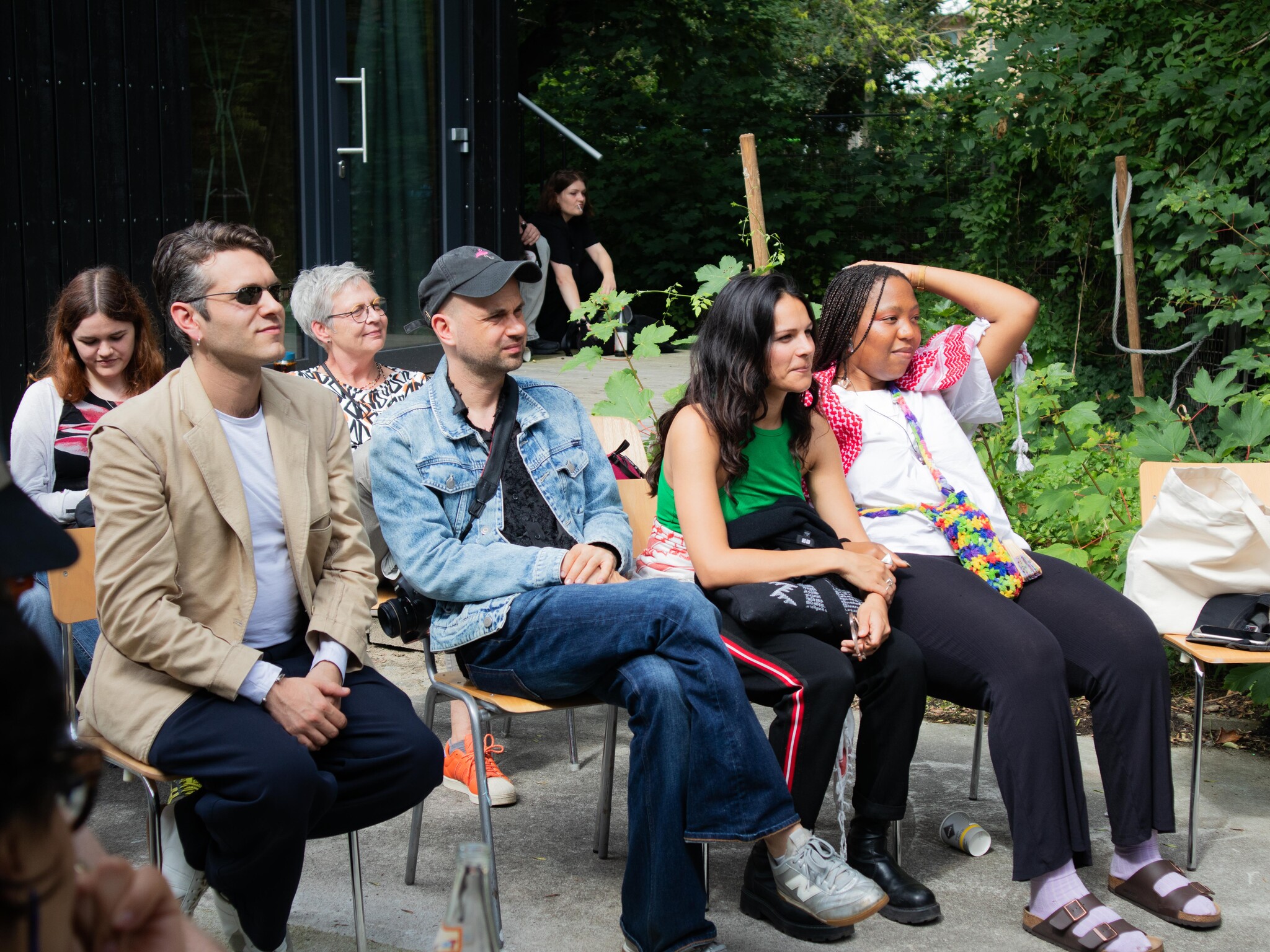
activates the peripheries at Kunsthalle am Hamburger Platz with a variety of sound related performances.
Alle Rechte vorbehalten Patricia Black
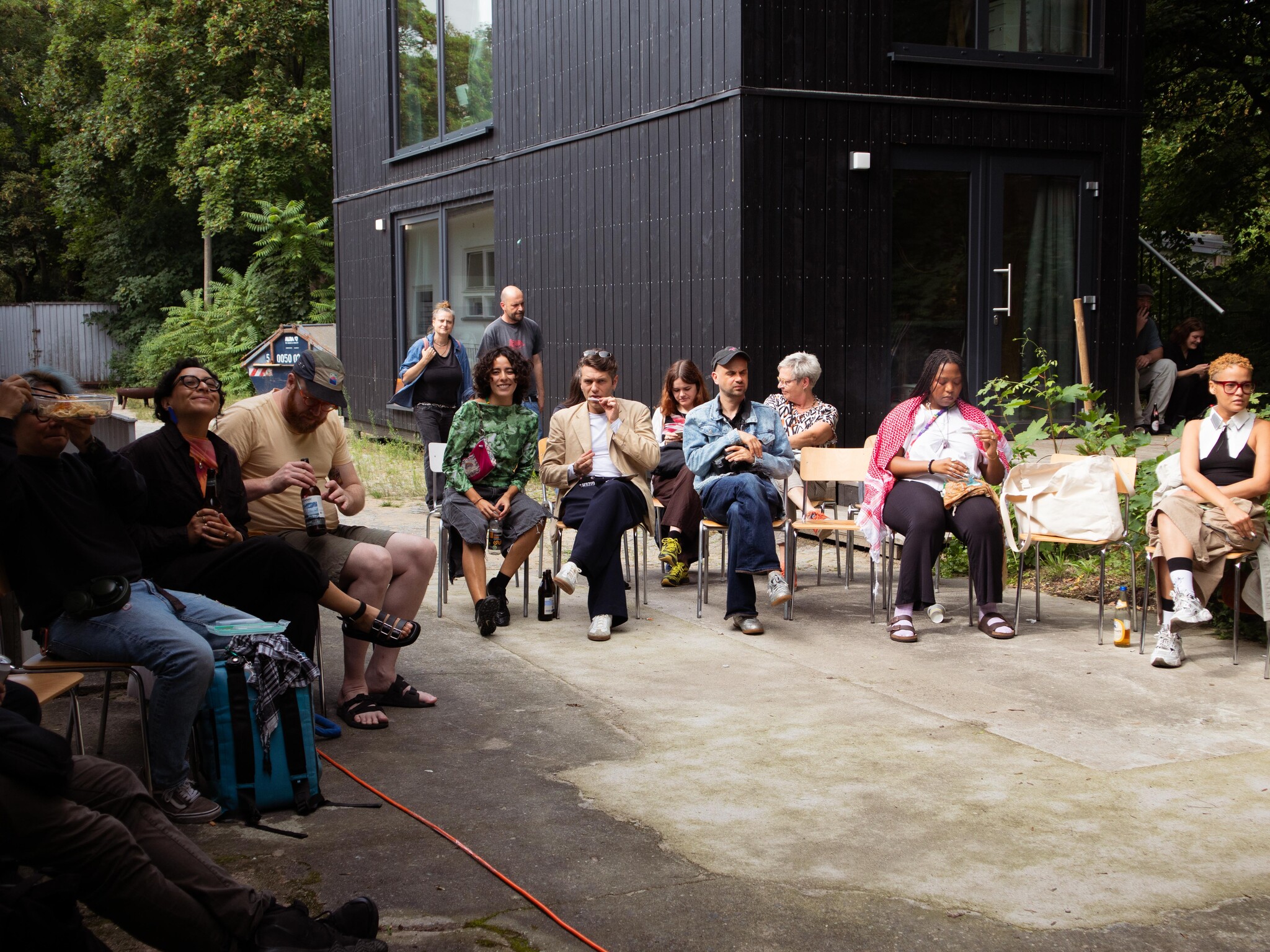
activates the peripheries at Kunsthalle am Hamburger Platz with a variety of sound related performances.
Alle Rechte vorbehalten Patricia Black
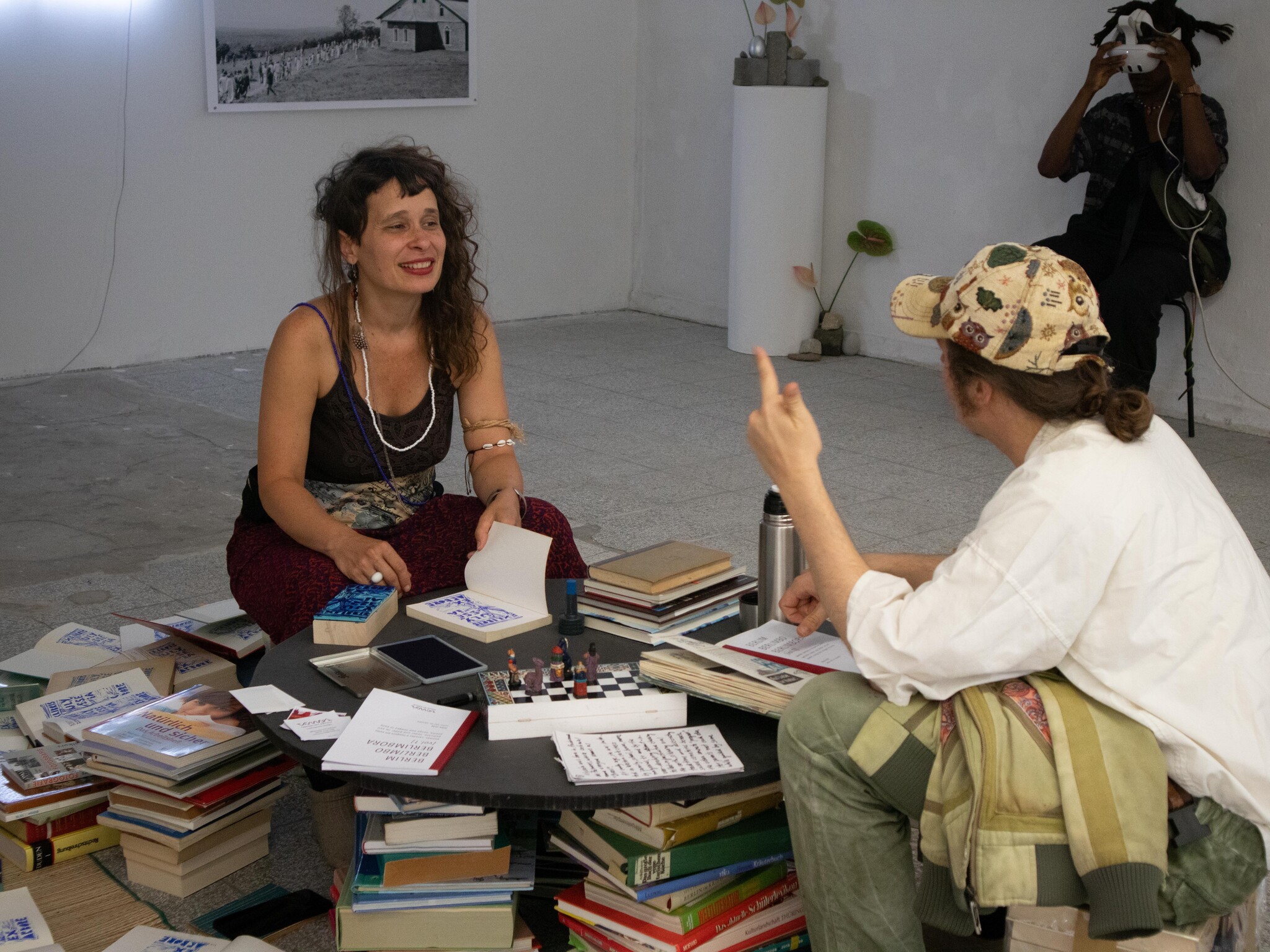
Since her first years in Berlimbo,
ulysséia observes that the noise
of machines usually sounds much
louder than the noise of human
voices around the city. Rejected
books are no longer burned here.
Still, when left for adoption on the
streets, they may become garbage
— absorbed into a cartography of
dog pee and forgetting.In between
the lines and pages of these books
ulysséia collected over the years
on the pavements of the city, is
also the silence of (unnumbered)
dead trees and suppressed oral
cultures—from which she came as
well.
Alle Rechte vorbehalten Patricia Black
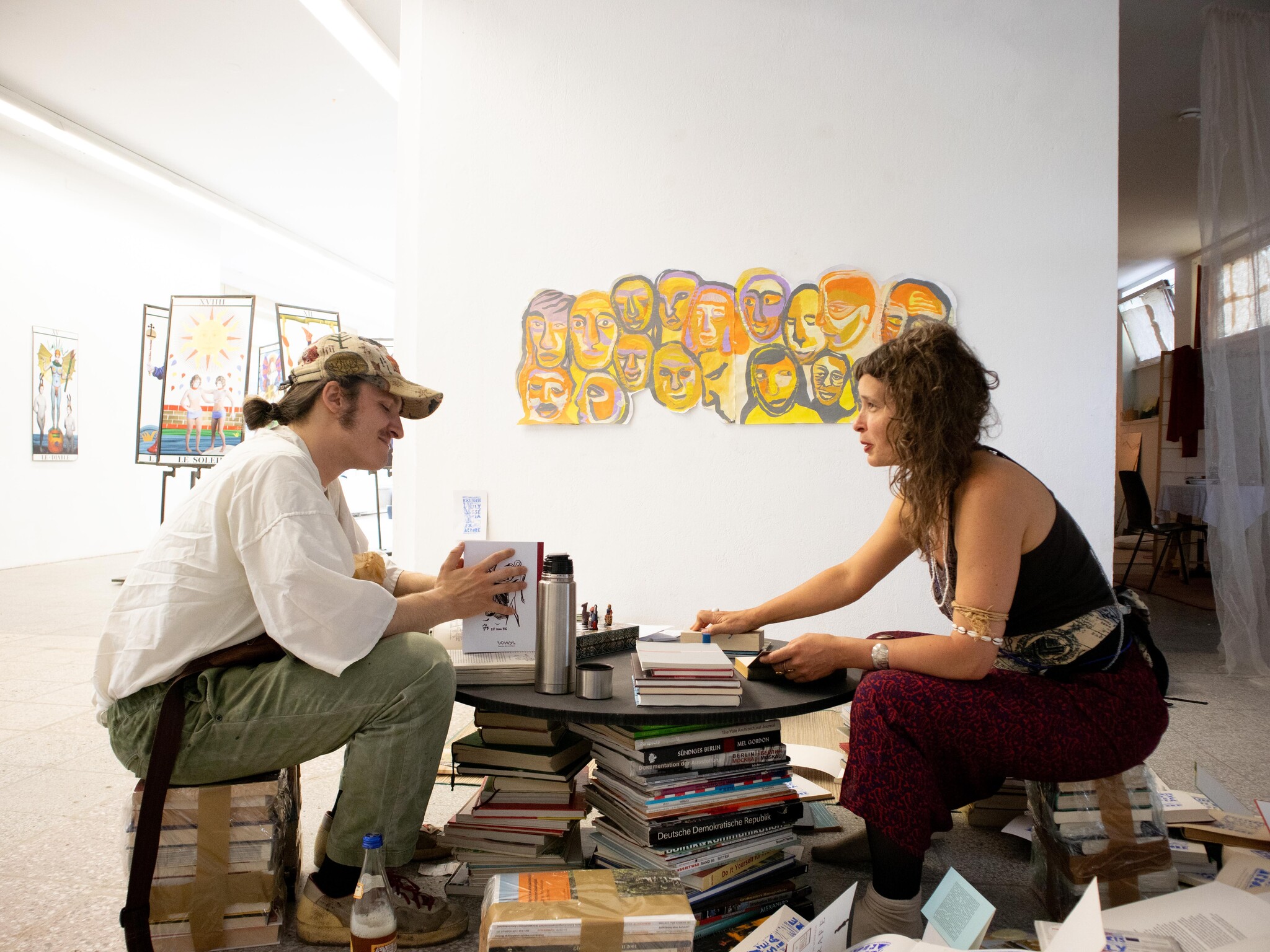
Since her first years in Berlimbo,
ulysséia observes that the noise
of machines usually sounds much
louder than the noise of human
voices around the city. Rejected
books are no longer burned here.
Still, when left for adoption on the
streets, they may become garbage
— absorbed into a cartography of
dog pee and forgetting.In between
the lines and pages of these books
ulysséia collected over the years
on the pavements of the city, is
also the silence of (unnumbered)
dead trees and suppressed oral
cultures—from which she came as
well.
Alle Rechte vorbehalten Patricia Black
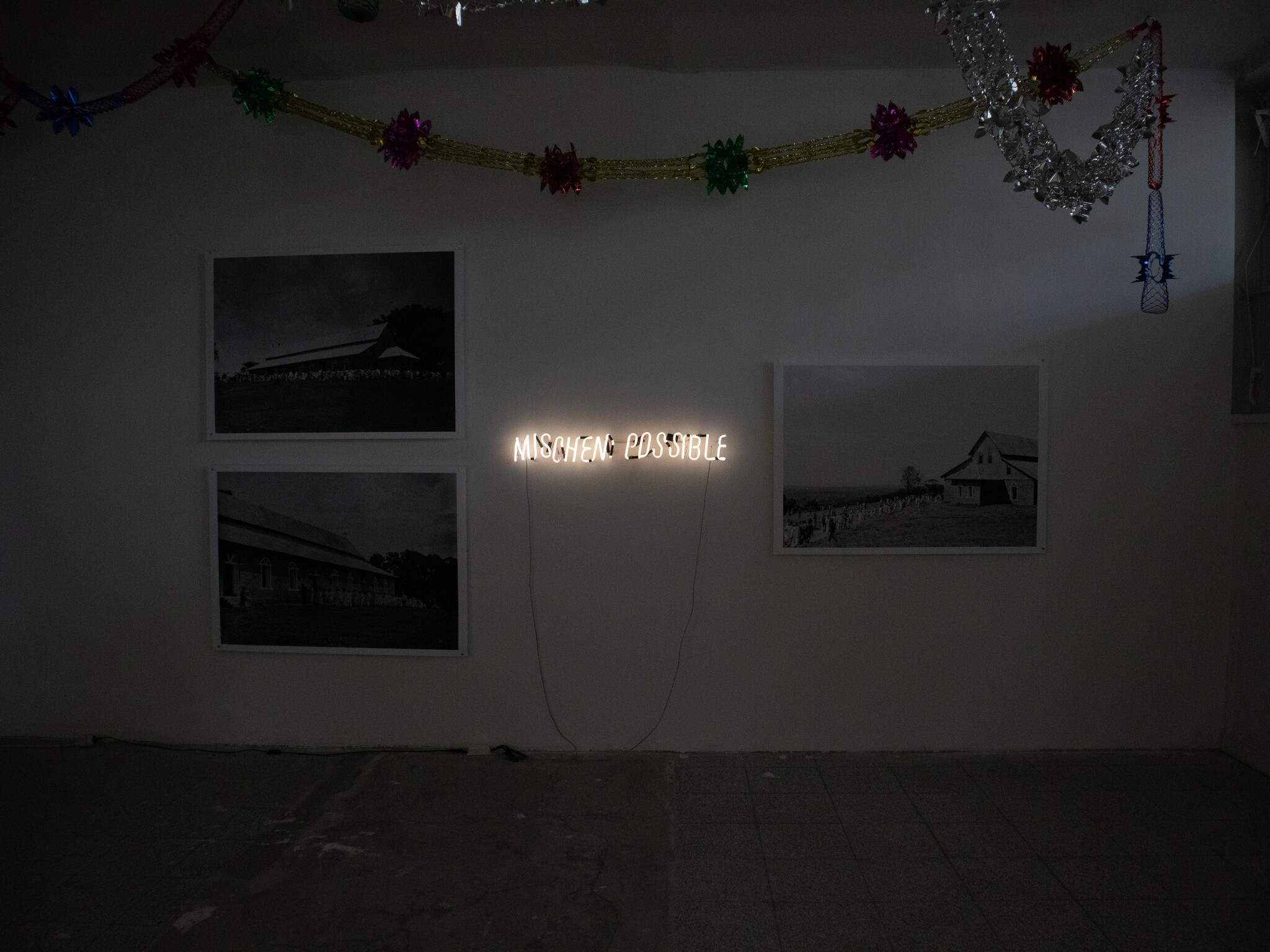
Installation with VR headset, archival
photographs, and neon light (“Mischen
possible”)
Dracaena Allee is an immersive
installation that weaves together virtual reality, family archives, and spatial interventions to explore ancestral memory, colonial rupture, and speculative repair.
At its center is a 16-minute VR experience guided by the sacred
Isale plant (Dracaena afromontana), a threshold between the living and ancestral worlds. Viewers enter a divided terrain—one grounded in matrilineal land stewardship and family architecture; the other disrupted by German missionary violence, ecological dispossession,} and archival erasure.
Surrounding the VR headset are photographs of a Lutheran church built by the artist’s great- grandfather—constructed for
missionaries whose later actions included the trafficking of human remains. Suspended nearby, a neon work titled Mischen Possible
references a stolen postcard and the misspellings found in German colonial records (e.g. “Shuma” rendered as “Schuma,” “Machame”
as “Madschame”). While Mischen translates from German as “mixing,” here it becomes Mission possible—a coded signal toward
repatriation and ancestral return.
The sign mirrors the dimensions of a postcard in height, but stretches the length of a kanga, the East African textile known for ferrying subversive messages.
The work engages critically with the aesthetics of green energy and sustainability—echoing Bomani’s long-term research into sisal, colonial engineering, and contemporary greenwashing.
Set within an institution that holds human remains, Dracaena Allee becomes a site of reckoning: with archives, with architecture, with light, and with the names that survive misspelled but unforgotten.
Alle Rechte vorbehalten Patricia Black
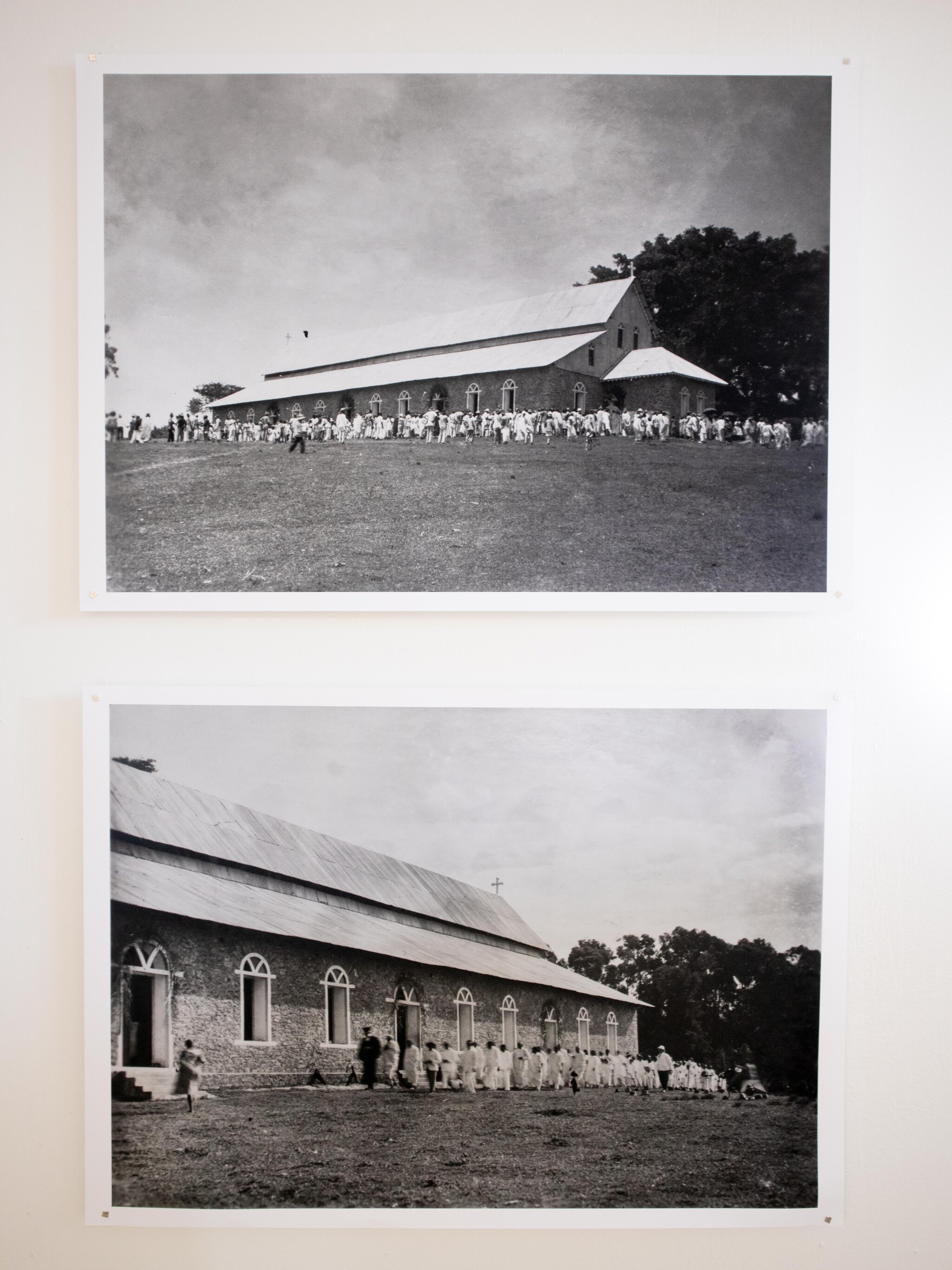
Installation with VR headset, archival
photographs, and neon light (“Mischen
possible”)
Dracaena Allee is an immersive
installation that weaves together virtual reality, family archives, and spatial interventions to explore ancestral memory, colonial rupture, and speculative repair.
At its center is a 16-minute VR experience guided by the sacred
Isale plant (Dracaena afromontana), a threshold between the living and ancestral worlds. Viewers enter a divided terrain—one grounded in matrilineal land stewardship and family architecture; the other disrupted by German missionary violence, ecological dispossession,} and archival erasure.
Surrounding the VR headset are photographs of a Lutheran church built by the artist’s great- grandfather—constructed for
missionaries whose later actions included the trafficking of human remains. Suspended nearby, a neon work titled Mischen Possible
references a stolen postcard and the misspellings found in German colonial records (e.g. “Shuma” rendered as “Schuma,” “Machame”
as “Madschame”). While Mischen translates from German as “mixing,” here it becomes Mission possible—a coded signal toward
repatriation and ancestral return.
Alle Rechte vorbehalten Patricia Black
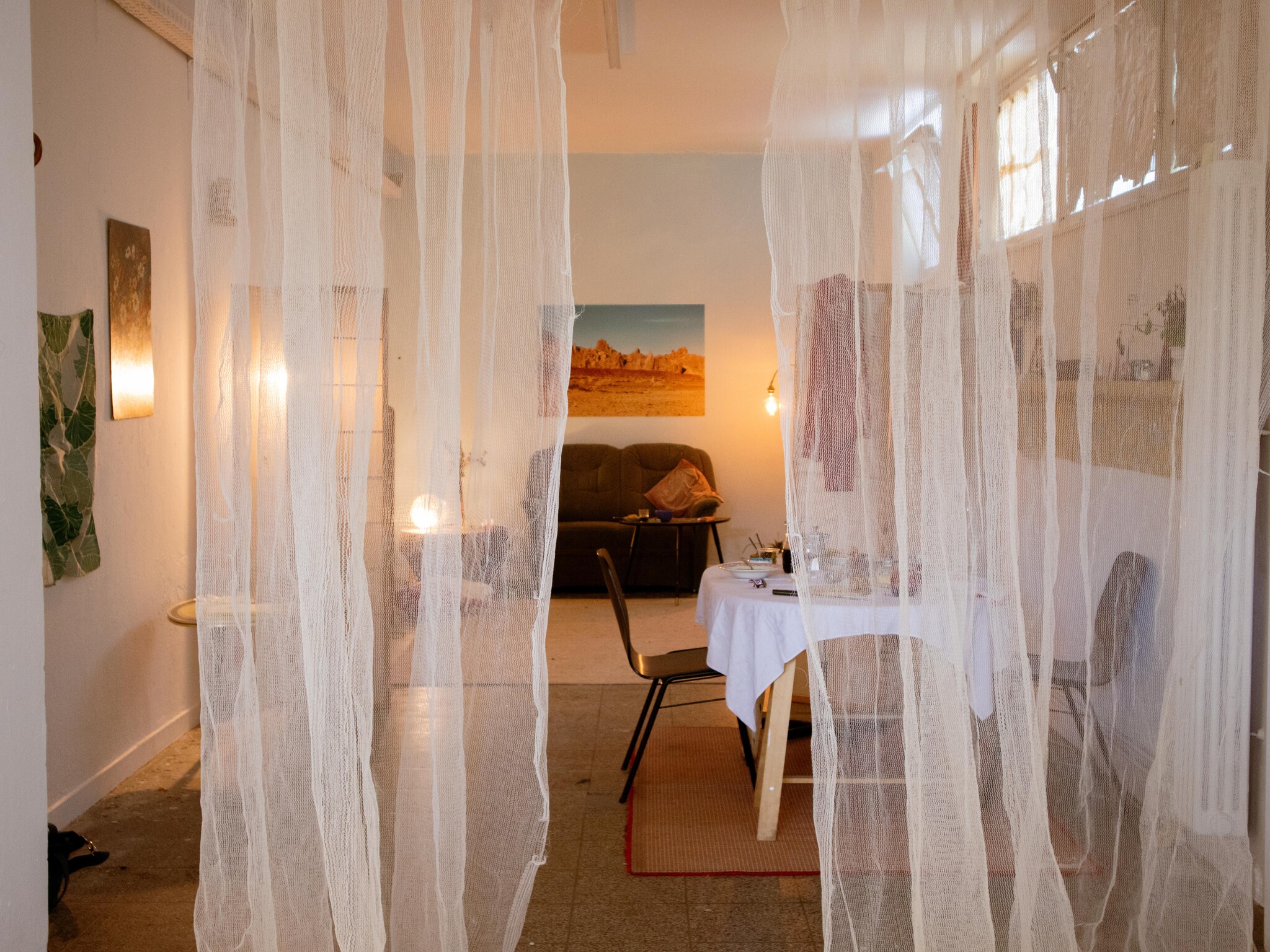
Found furniture, inherited fabrics & other people’s memories
What makes one leave a beloved
place in a hurry?
Alle Rechte vorbehalten Patricia Black
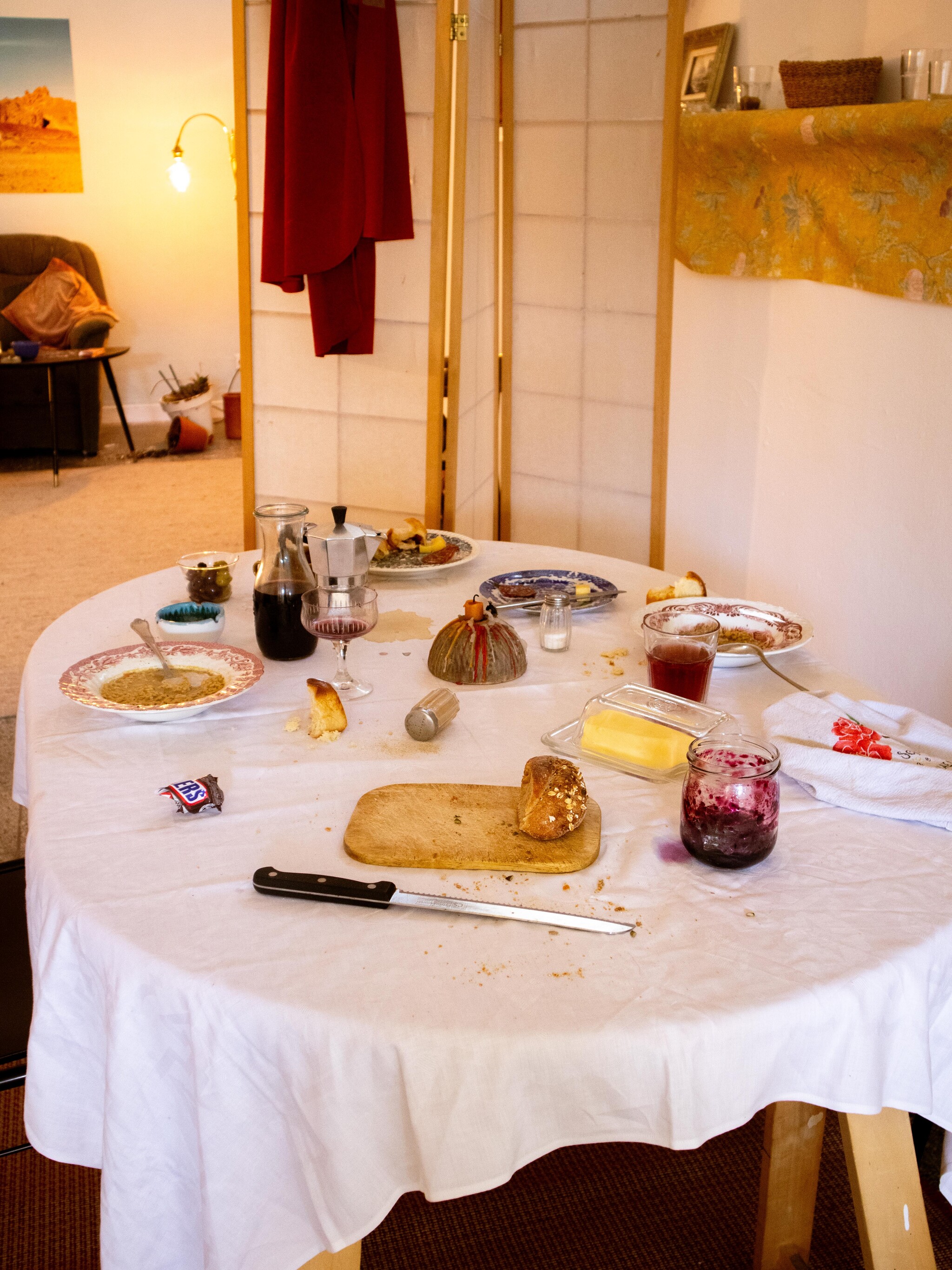
Found furniture, inherited fabrics & other people’s memories
What makes one leave a beloved
place in a hurry?
Alle Rechte vorbehalten Patricia Black
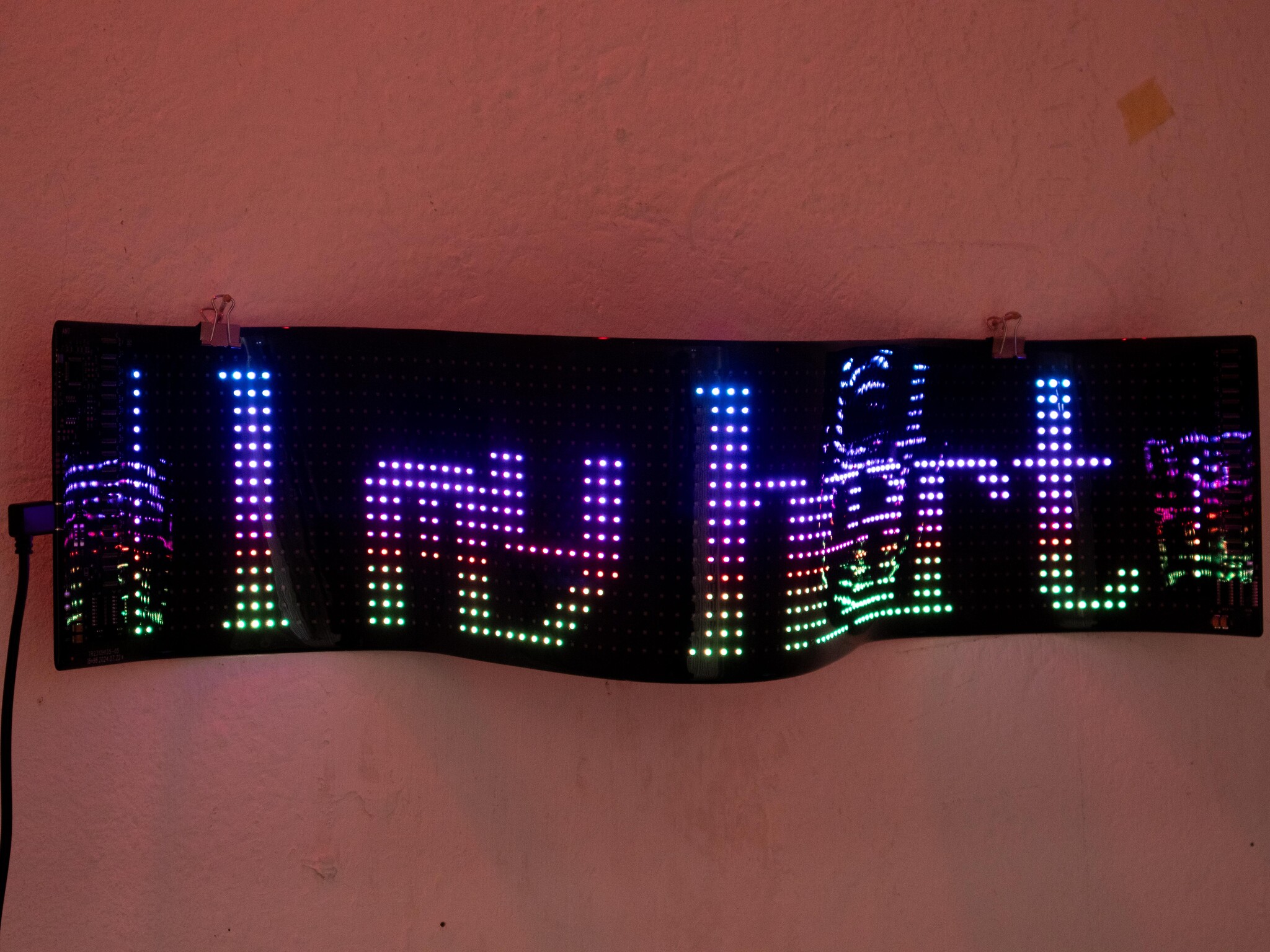
Voice, sorrow, connection—
again and again, censored, si-
lenced, stripped away.
We are taught how to stay calm,
but never how to grieve.
In this turbulent time,
how do we dissolve political de-
pression?
My therapist said:
“Try to find something you can do
alone, with joy.”
So I began to sing.
In my room, old melodies—
songs once part of history, of pop
culture—
have now become whispers in my
dialogue with the world.
I rewrite the lyrics, reshape the mel-
odies, embed poems within.
Words I can’t say outright
slip into the air through music—
both an emotional release
and a quiet act of resistance.
During the exhibition,
I sing in this small room from time
to time.
Visitors who carry the same weight
of melancholy
are invited to step into this intimate
space,
choose your own song of release,
and sing it, too.
We need songs and poems—
not a hopeless world.
Alle Rechte vorbehalten Patricia Black
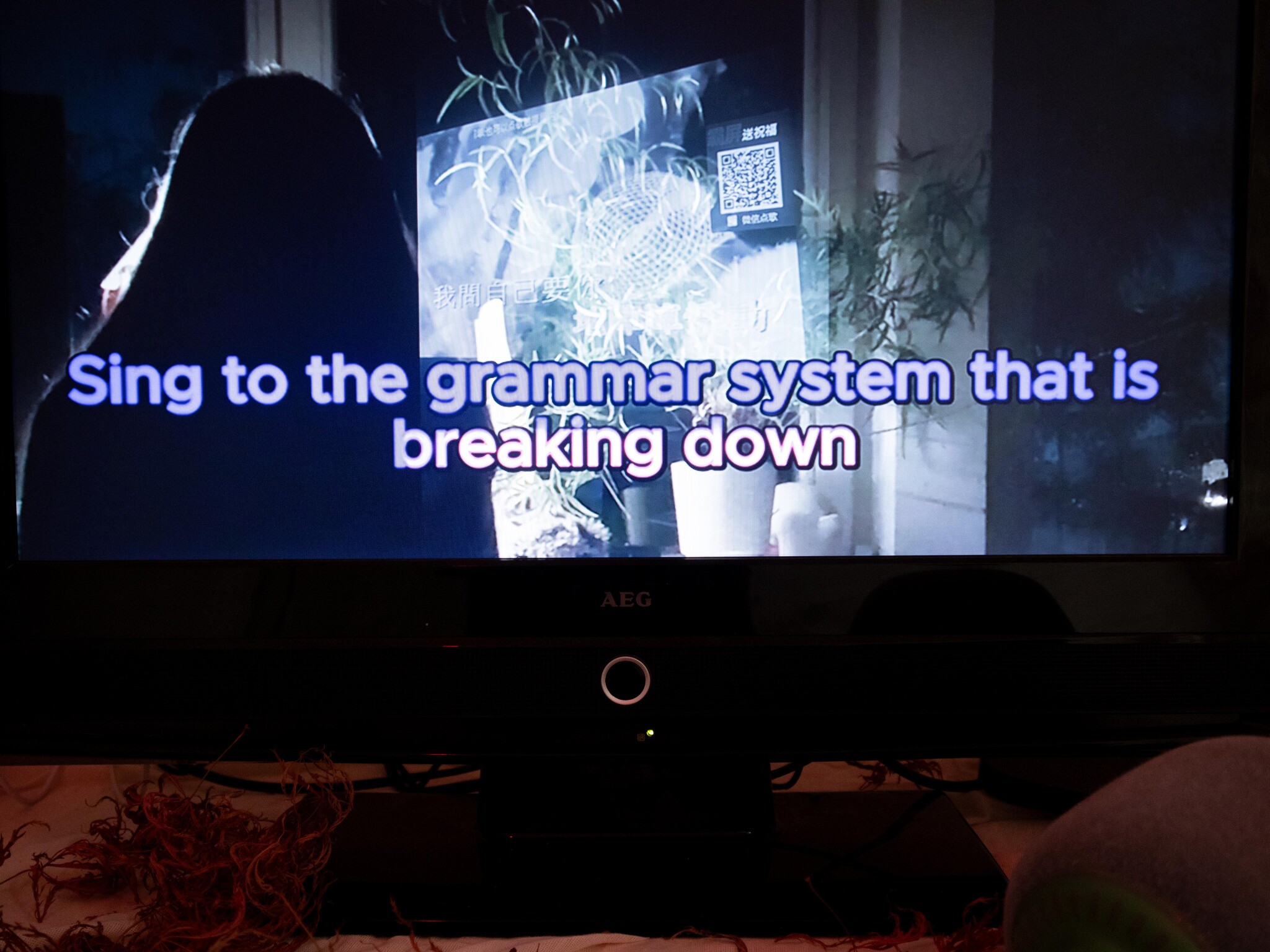
Voice, sorrow, connection—
again and again, censored, si-
lenced, stripped away.
We are taught how to stay calm,
but never how to grieve.
In this turbulent time,
how do we dissolve political de-
pression?
My therapist said:
“Try to find something you can do
alone, with joy.”
So I began to sing.
In my room, old melodies—
songs once part of history, of pop
culture—
have now become whispers in my
dialogue with the world.
I rewrite the lyrics, reshape the mel-
odies, embed poems within.
Words I can’t say outright
slip into the air through music—
both an emotional release
and a quiet act of resistance.
During the exhibition,
I sing in this small room from time
to time.
Visitors who carry the same weight
of melancholy
are invited to step into this intimate
space,
choose your own song of release,
and sing it, too.
We need songs and poems—
not a hopeless world.
Alle Rechte vorbehalten Patricia Black
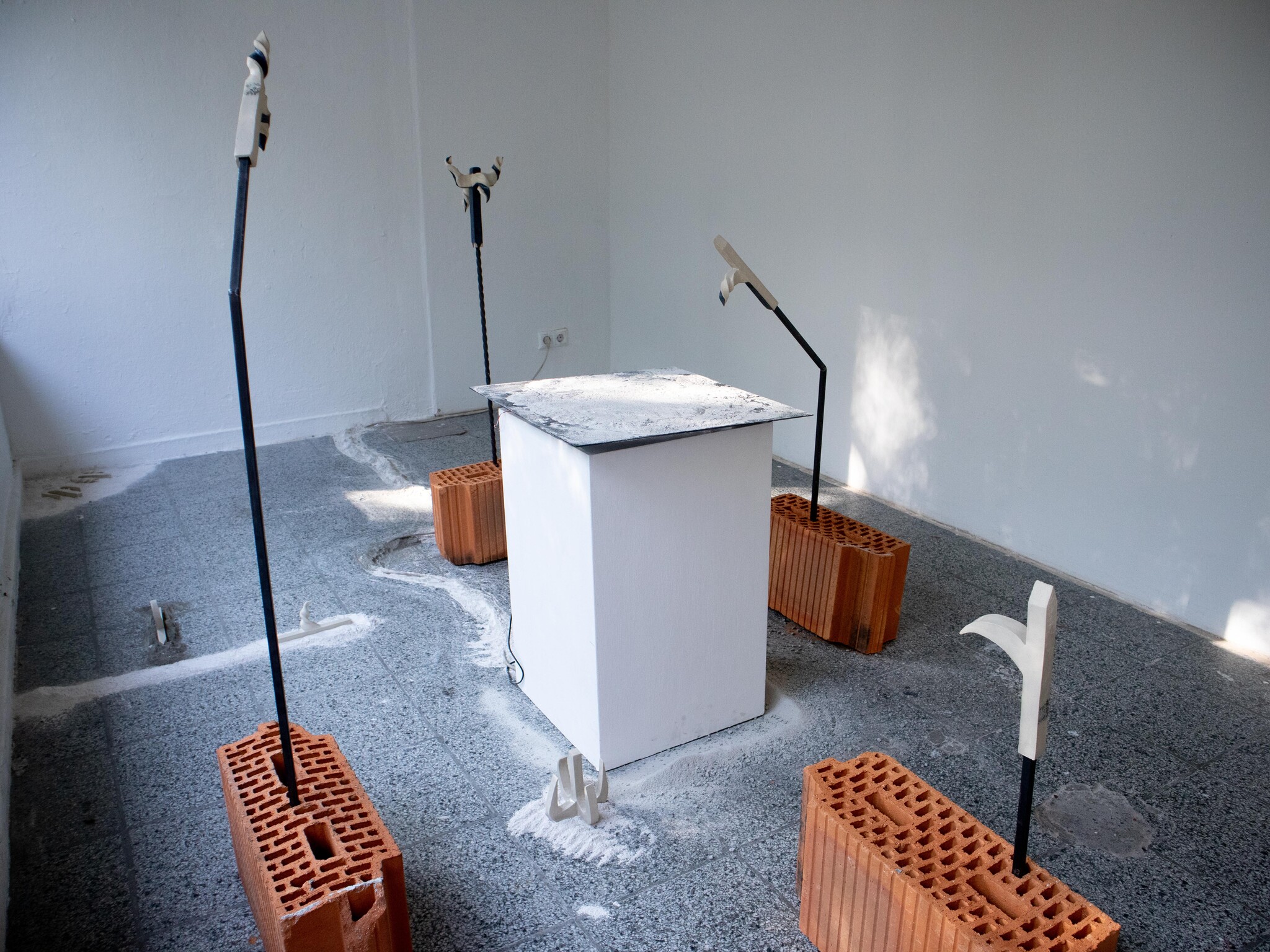
This work draws on an archival
family video from a childhood
vacation in Oaxaca, Mexico, titled
Vacations. I use this video as a
point of departure to create an in-
stallation that explores imagination
as a means of reconnecting with
family histories and rethinking the
conservative narratives my family
constructed, particularly through
the metaphor of dismantling the
fences of my childhood home. I
think about the welcome to a place where fences and architectural
context push you out.
Alle Rechte vorbehalten Patricia Black
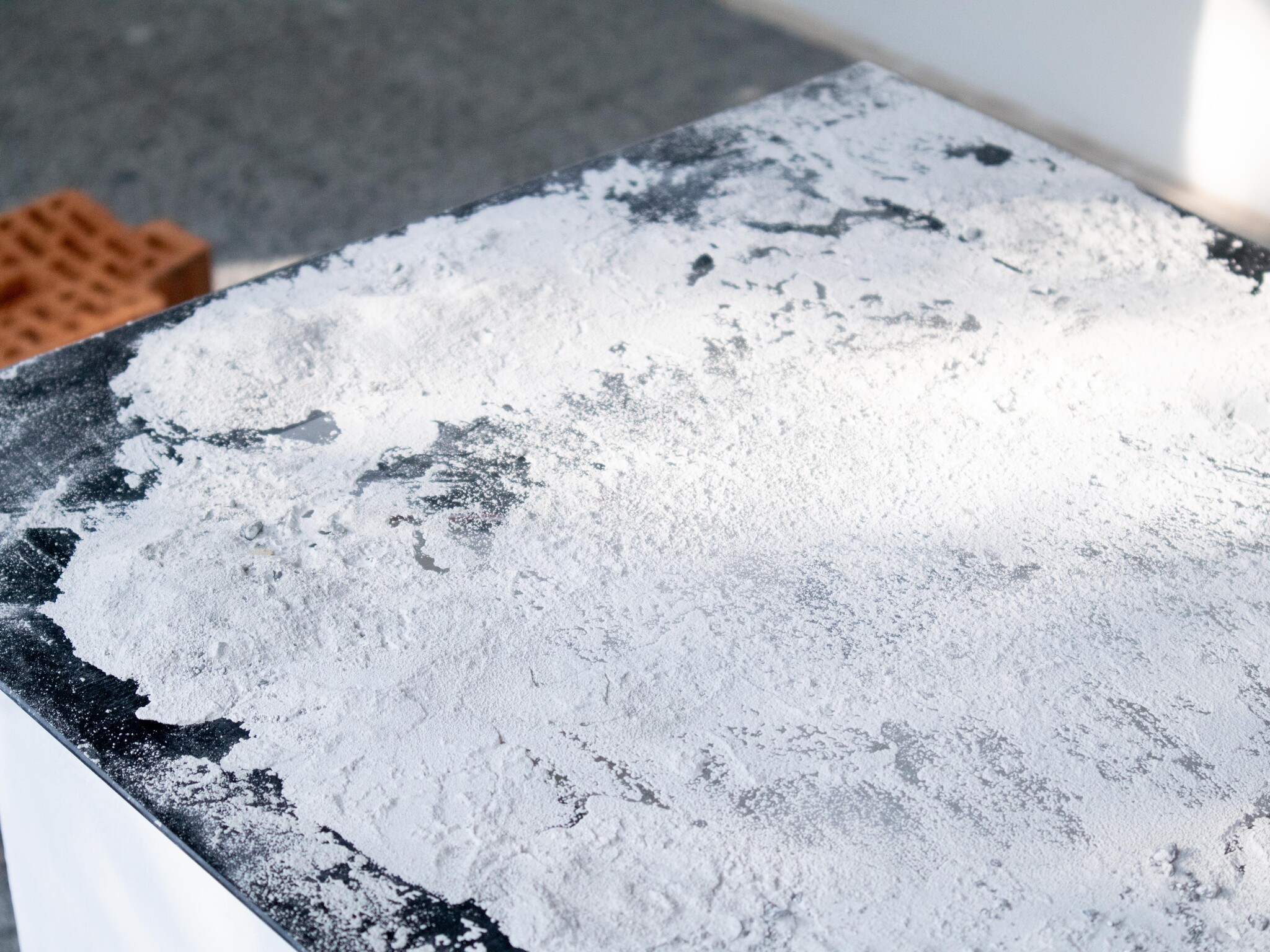
This work draws on an archival
family video from a childhood
vacation in Oaxaca, Mexico, titled
Vacations. I use this video as a
point of departure to create an in-
stallation that explores imagination
as a means of reconnecting with
family histories and rethinking the
conservative narratives my family
constructed, particularly through
the metaphor of dismantling the
fences of my childhood home. I
think about the welcome to a place
where fences and architectural
context push you out.
Alle Rechte vorbehalten Patricia Black
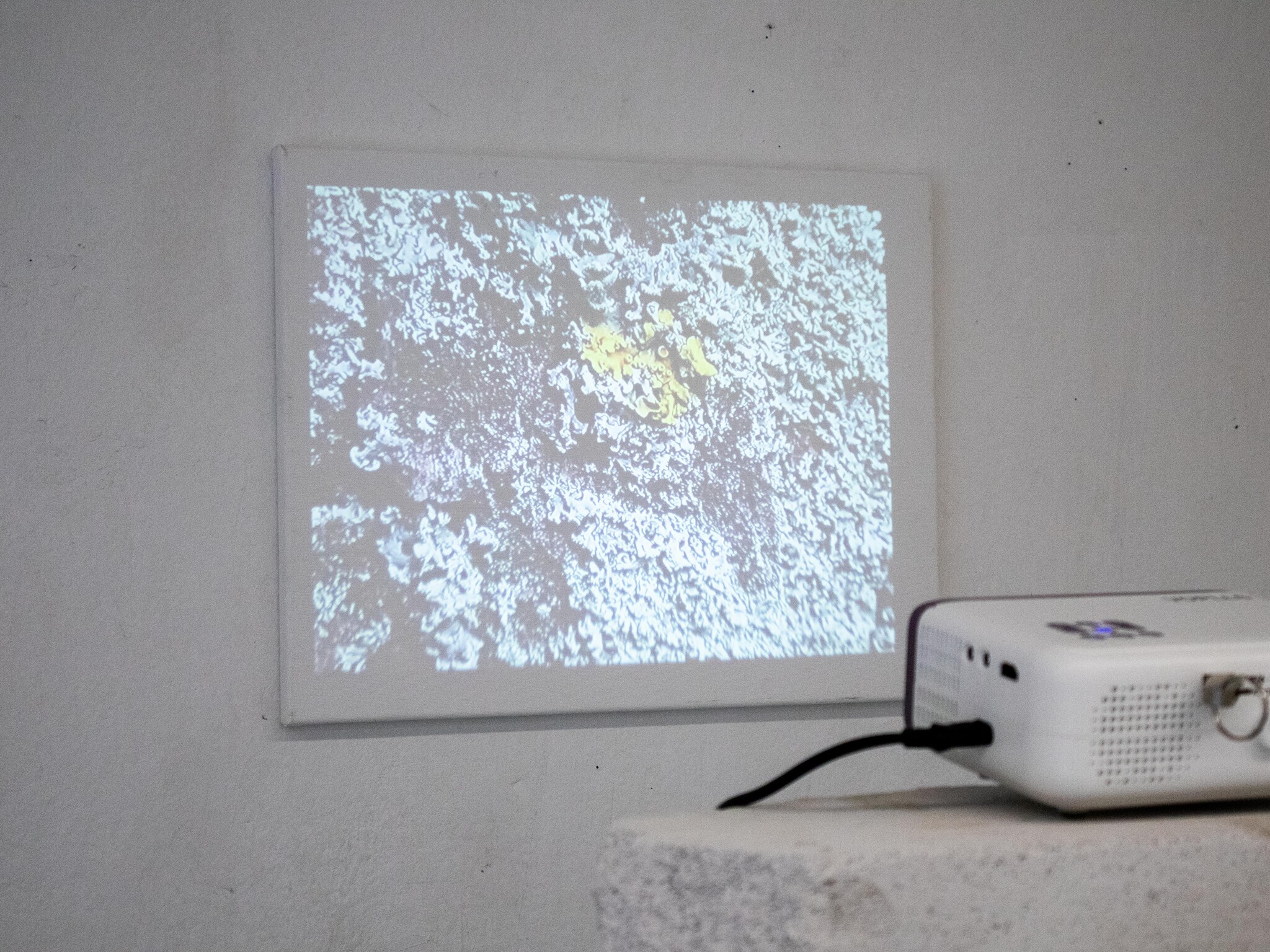
A video piece on lichens, filmed at
Floating University. An exploration
of matter, surface, and slow time.
Alle Rechte vorbehalten Patricia Black
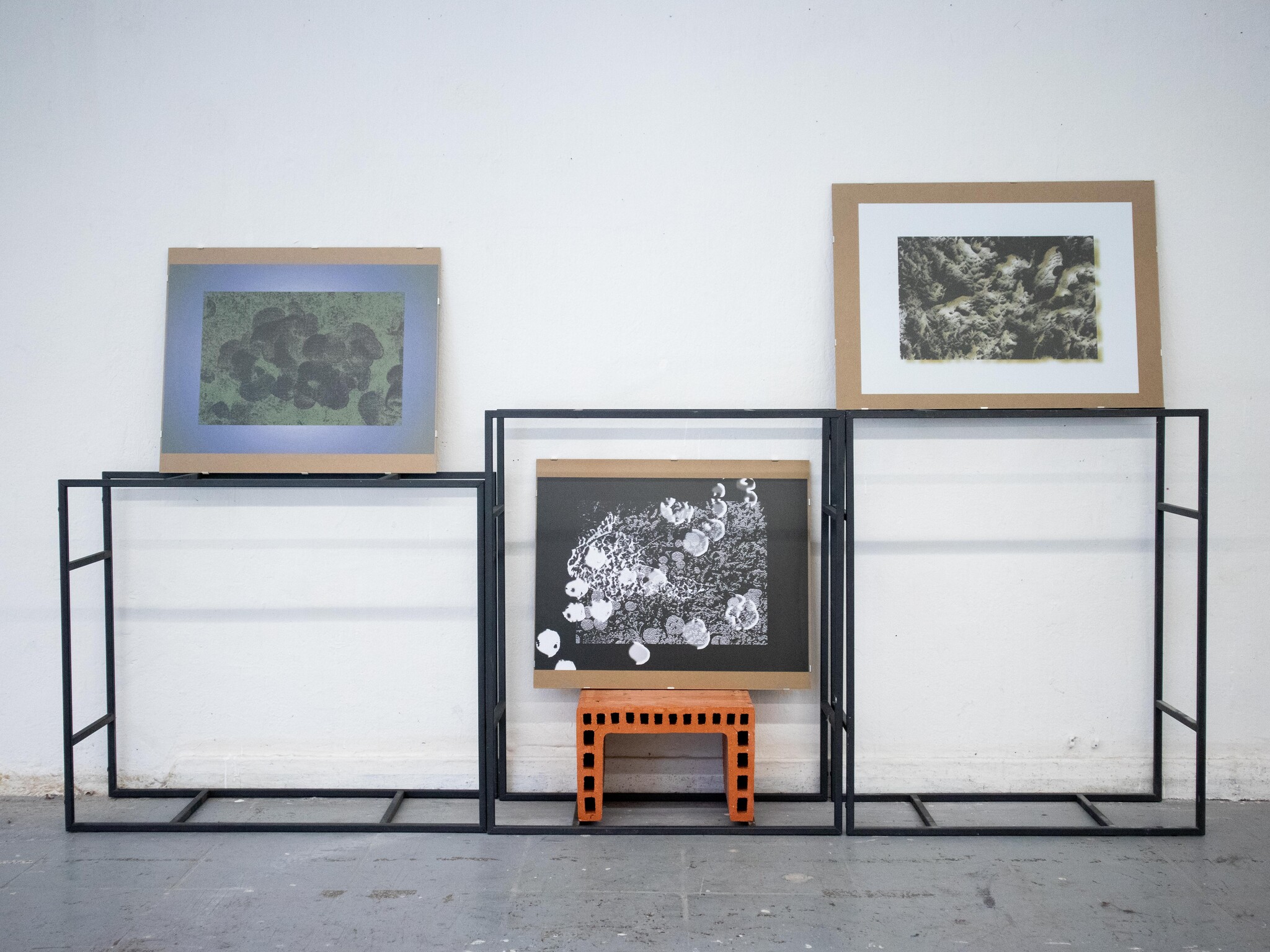
A series of three works mapping the micro-topographies of lichens,moving between landscape, erosion, and drawing.
Developed as a visual extension of the publication Lichens: A Slow In-surrection, created in collaboration with Laura Mas.
Alle Rechte vorbehalten Patricia Black
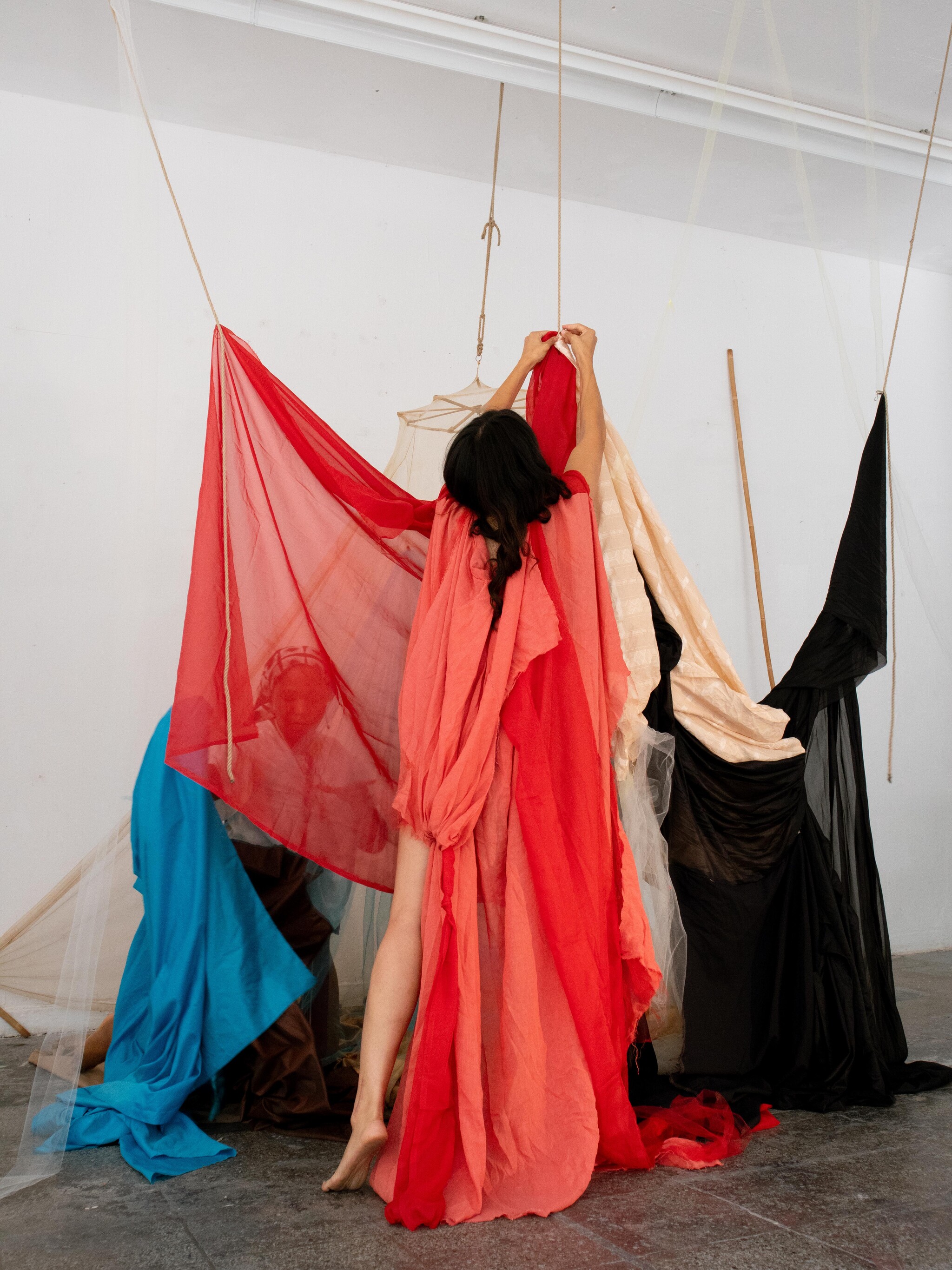
“The Cocoon of Shifting Dreams” is a performative installation that explores dreaming as a political and collective force against systemic exhaustion, precarity, displacement, and the capture of time, imagination, and desire. In the face of accelerating crises and colonial violence, dreaming becomes a radical tool for survival—an act of refusal, care, and worldbuilding against all odds. Rooted in decolonial, diasporic, and feminist practices, the work asks: Whose dreams are stolen, silenced, or commodified?
Four cocoons sown together from leftover textile scraps hang suspended, representing entangled dreamscapes, interwoven in utopia, dystopia and dreamlessness. Through performance, the cocoons unravel into sculptural dream(s)capes eventually creating an embodied space - a temporary architecture for gathering, reflection, and speculative visioning.
One cocoon remains hollow. Yet, it invites transformation. Visitors are called to weave their own visions into its surface at the Dream Weaving Station, sewing in scraps, threads, and memories. As collective dreams accumulate, the cocoon begins to shift, animating what capitalism, colonialism and imperialism attempt to suffocate. In this shared act of imagination, the installation becomes a space of resistance and reassembly, where dreaming is reclaimed as a political right and a collective force. The dreamskins breathe, stretch, and reveal hidden layers, turning textile into a living, critical archive.
This performative installation emerges from the collaborative project “Dreaming Change”, initiated in 2021, as part of Dhakal’s Master Thesis Project in Global Studies. It premiered as part of the exhibition “verträumt” by artburst berlin, and was further hosted by Co2libri, Fragile Behausungen conference, and Queer Unschool South Asia. The Dreamspace, alongside its workshops and performances, remains an ongoing, relational process: open to change, critique, and collective transformation. Rather than seeking resolution, it embraces its unfinished nature as a space for creative experimentation, shared learning, and speculative imagination.
Special thanks: My heartfelt gratitude to Anna Lena Ballweg who not only introduced me patiently to the world of sewing machines but embraced this project with so much openness, curiosity, creativity and gentle guidance - without you, the dream(s)capes would have not emerged.
Alle Rechte vorbehalten Patricia Black
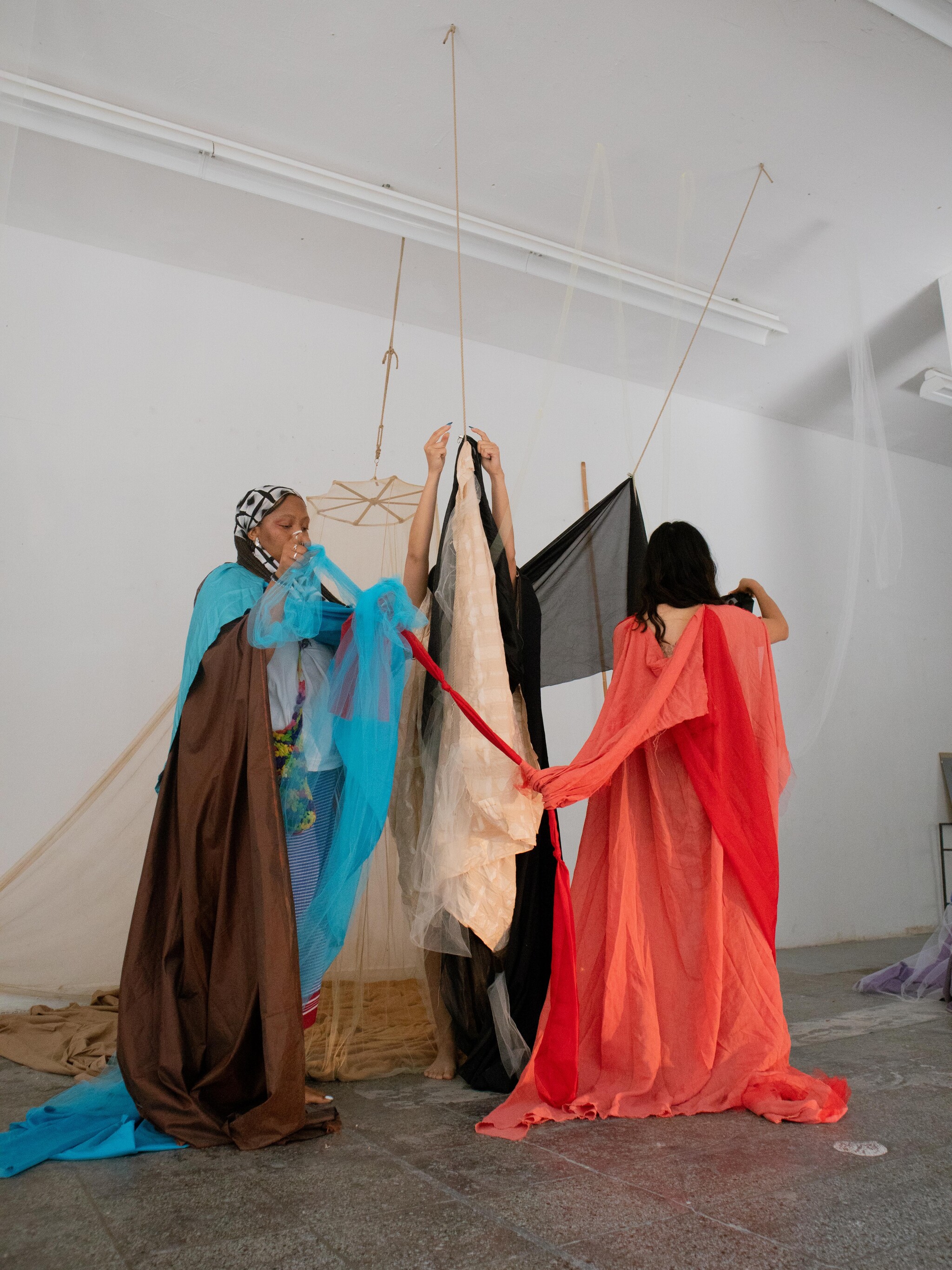
“The Cocoon of Shifting Dreams” is a performative installation that explores dreaming as a political and collective force against systemic exhaustion, precarity, displacement, and the capture of time, imagination, and desire. In the face of accelerating crises and colonial violence, dreaming becomes a radical tool for survival—an act of refusal, care, and worldbuilding against all odds. Rooted in decolonial, diasporic, and feminist practices, the work asks: Whose dreams are stolen, silenced, or commodified?
Four cocoons sown together from leftover textile scraps hang suspended, representing entangled dreamscapes, interwoven in utopia, dystopia and dreamlessness. Through performance, the cocoons unravel into sculptural dream(s)capes eventually creating an embodied space - a temporary architecture for gathering, reflection, and speculative visioning.
One cocoon remains hollow. Yet, it invites transformation. Visitors are called to weave their own visions into its surface at the Dream Weaving Station, sewing in scraps, threads, and memories. As collective dreams accumulate, the cocoon begins to shift, animating what capitalism, colonialism and imperialism attempt to suffocate. In this shared act of imagination, the installation becomes a space of resistance and reassembly, where dreaming is reclaimed as a political right and a collective force. The dreamskins breathe, stretch, and reveal hidden layers, turning textile into a living, critical archive.
This performative installation emerges from the collaborative project “Dreaming Change”, initiated in 2021, as part of Dhakal’s Master Thesis Project in Global Studies. It premiered as part of the exhibition “verträumt” by artburst berlin, and was further hosted by Co2libri, Fragile Behausungen conference, and Queer Unschool South Asia. The Dreamspace, alongside its workshops and performances, remains an ongoing, relational process: open to change, critique, and collective transformation. Rather than seeking resolution, it embraces its unfinished nature as a space for creative experimentation, shared learning, and speculative imagination.
Special thanks: My heartfelt gratitude to Anna Lena Ballweg who not only introduced me patiently to the world of sewing machines but embraced this project with so much openness, curiosity, creativity and gentle guidance - without you, the dream(s)capes would have not emerged.
Alle Rechte vorbehalten Patricia Black
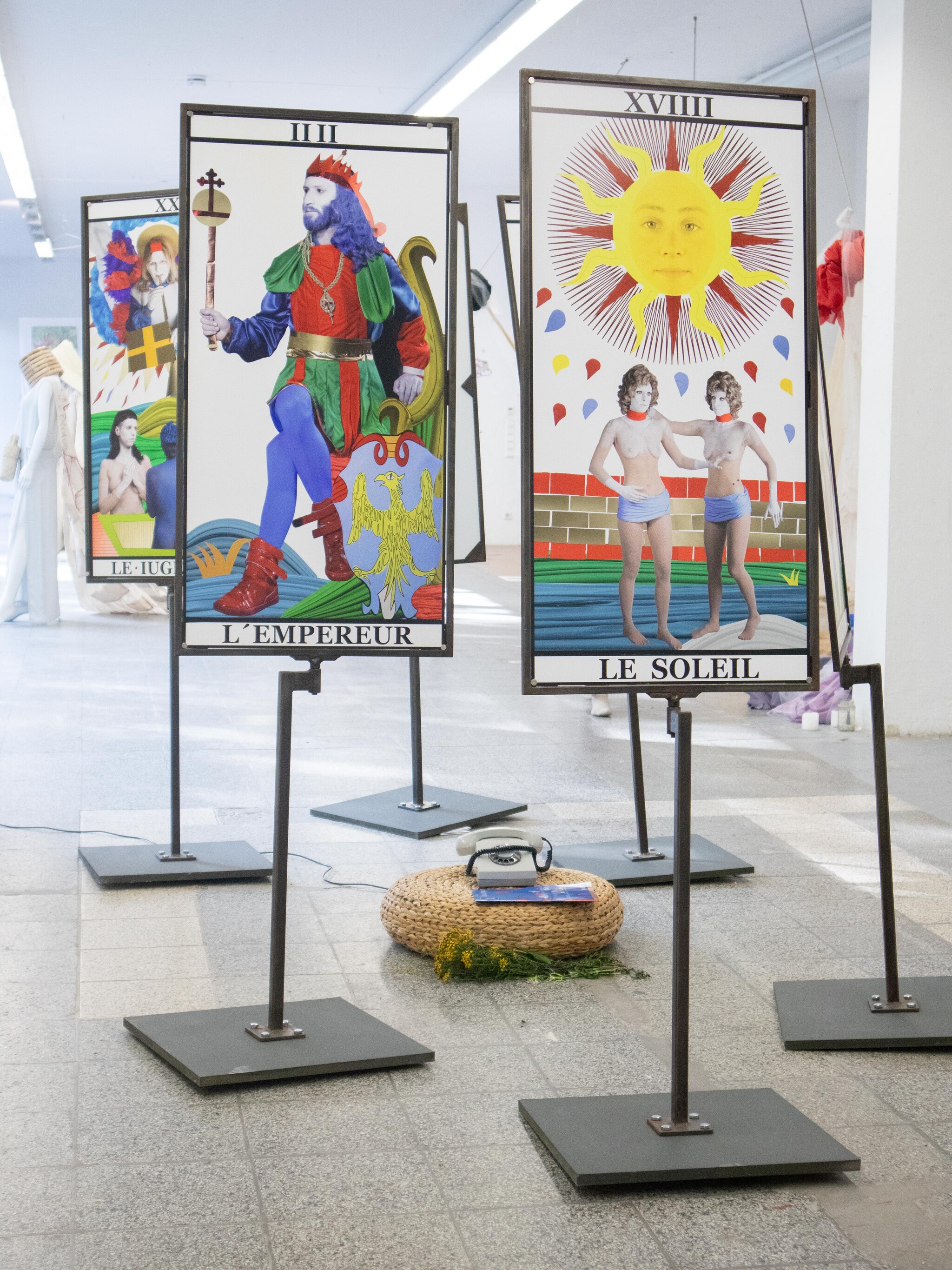
The End of the Line weaves protest and vulnerability into a space of radical listening. Six metal placards—resembling protest signs—form a circle around a round table with a rotary telephone. When lifted, a voice begins to speak for 45 minutes: a confession, a memory, a longing—too fragile for the public realm.
This is not a performance, but a transmission. The speaker does not know who listens. The listener cannot respond. The telephone becomes a threshold—between intimacy and distance, hospitality and refusal.
At the heart of the installation, two tarot cards—The Sun and The Moon—emerge from the artist’s 22+1 performance, serving as portals of visual alchemy. Their presence conjures dualities: illumination and obscurity, revelation and concealment. Set against a backdrop of flames and raised hands, The End of the Line becomes a ritual of resistance and reawakening. In a world engulfed by despair, the work insists on looking beyond: toward what is vast, cyclical, and enduring. Through the sacred act of listening, it invites a shared attunement—reminding us that art, in its essence, holds the capacity to rethread us into the larger weave of being.
Alle Rechte vorbehalten Patricia Black
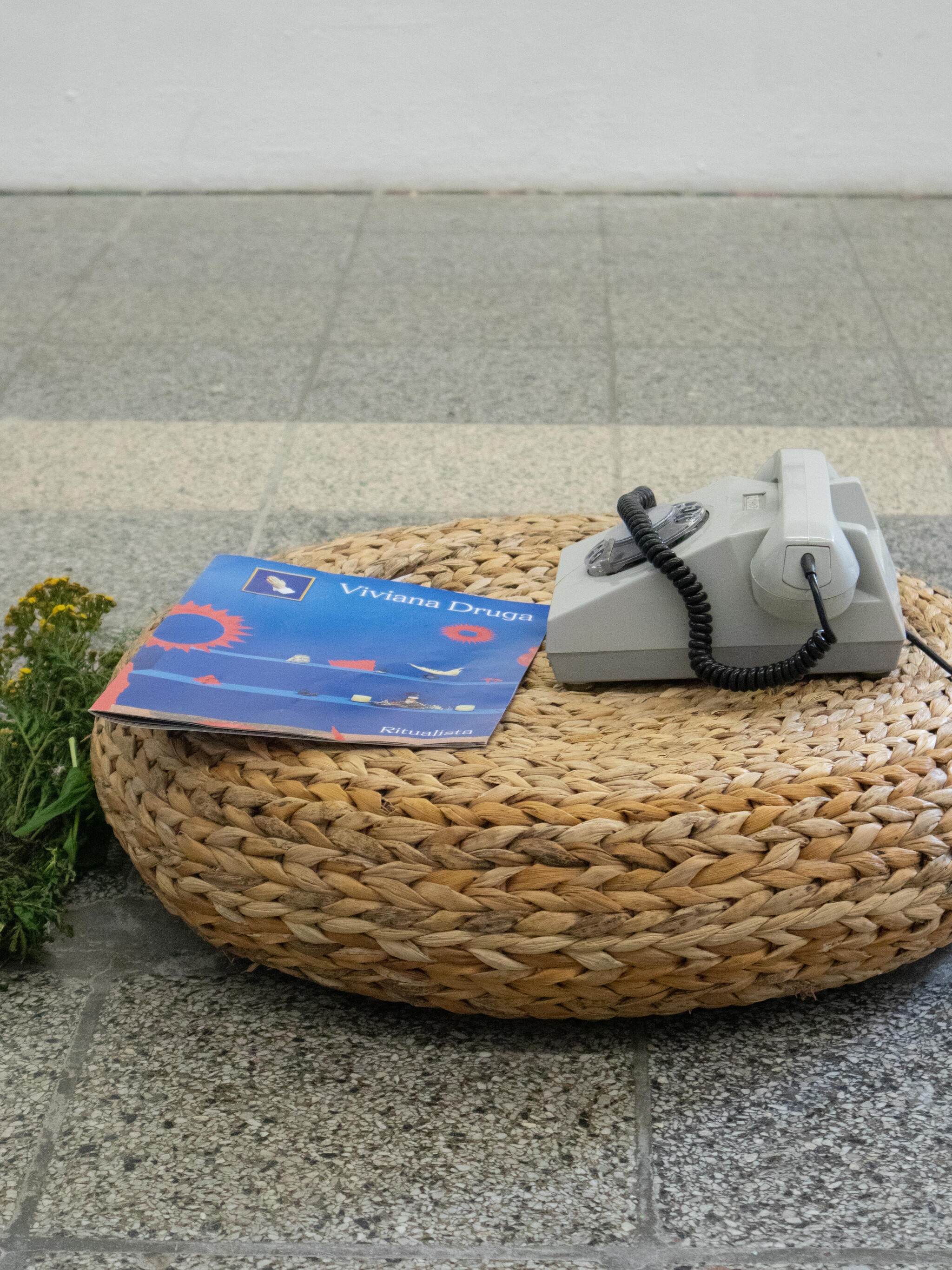
The End of the Line weaves protest and vulnerability into a space of radical listening. Six metal placards—resembling protest signs—form a circle around a round table with a rotary telephone. When lifted, a voice begins to speak for 45 minutes: a confession, a memory, a longing—too fragile for the public realm.
This is not a performance, but a transmission. The speaker does not know who listens. The listener cannot respond. The telephone becomes a threshold—between intimacy and distance, hospitality and refusal.
At the heart of the installation, two tarot cards—The Sun and The Moon—emerge from the artist’s 22+1 performance, serving as portals of visual alchemy. Their presence conjures dualities: illumination and obscurity, revelation and concealment. Set against a backdrop of flames and raised hands, The End of the Line becomes a ritual of resistance and reawakening. In a world engulfed by despair, the work insists on looking beyond: toward what is vast, cyclical, and enduring. Through the sacred act of listening, it invites a shared attunement—reminding us that art, in its essence, holds the capacity to rethread us into the larger weave of being.
Alle Rechte vorbehalten Patricia Black
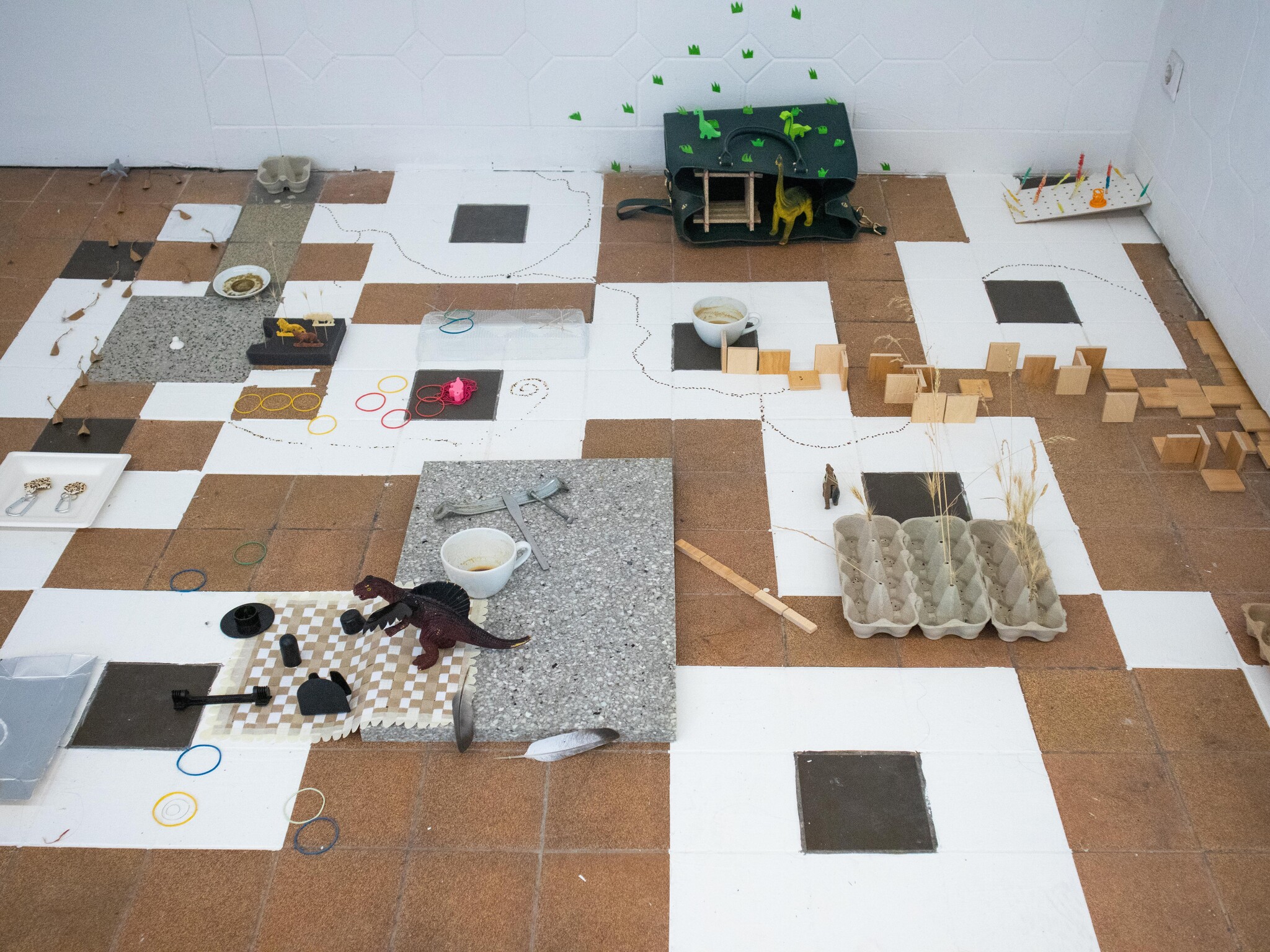
Cutting letters from second-hand children’s clothes I’ve collected, and stitched them into slogans on small flags.
While listening to a podcast, I heard they use the term homonationalism to justify massacres in the Middle East. For some reason, it suddenly reminded me of transphobic conservatives in the U.S.—and I thought, could they actually get along with my parents? Maybe even with my uncles who curse America every day? Especially now, when the relationship between China and the U.S. is so delicate... That’s when I started thinking about slogans again—like “One Planet” or “Workers of the World, Unite.”
In the wake of the collapse of globalization as a fantasy, I wanted to respond with a kind of joke—to mourn that lost dream of a beautifully interconnected world.
Out of the ruins of internationalism and cosmopolitanism, At the same time, the exposure of trauma becomes a form of self-mockery, and also a quiet act of reaffirmation.
Alle Rechte vorbehalten Patricia Black
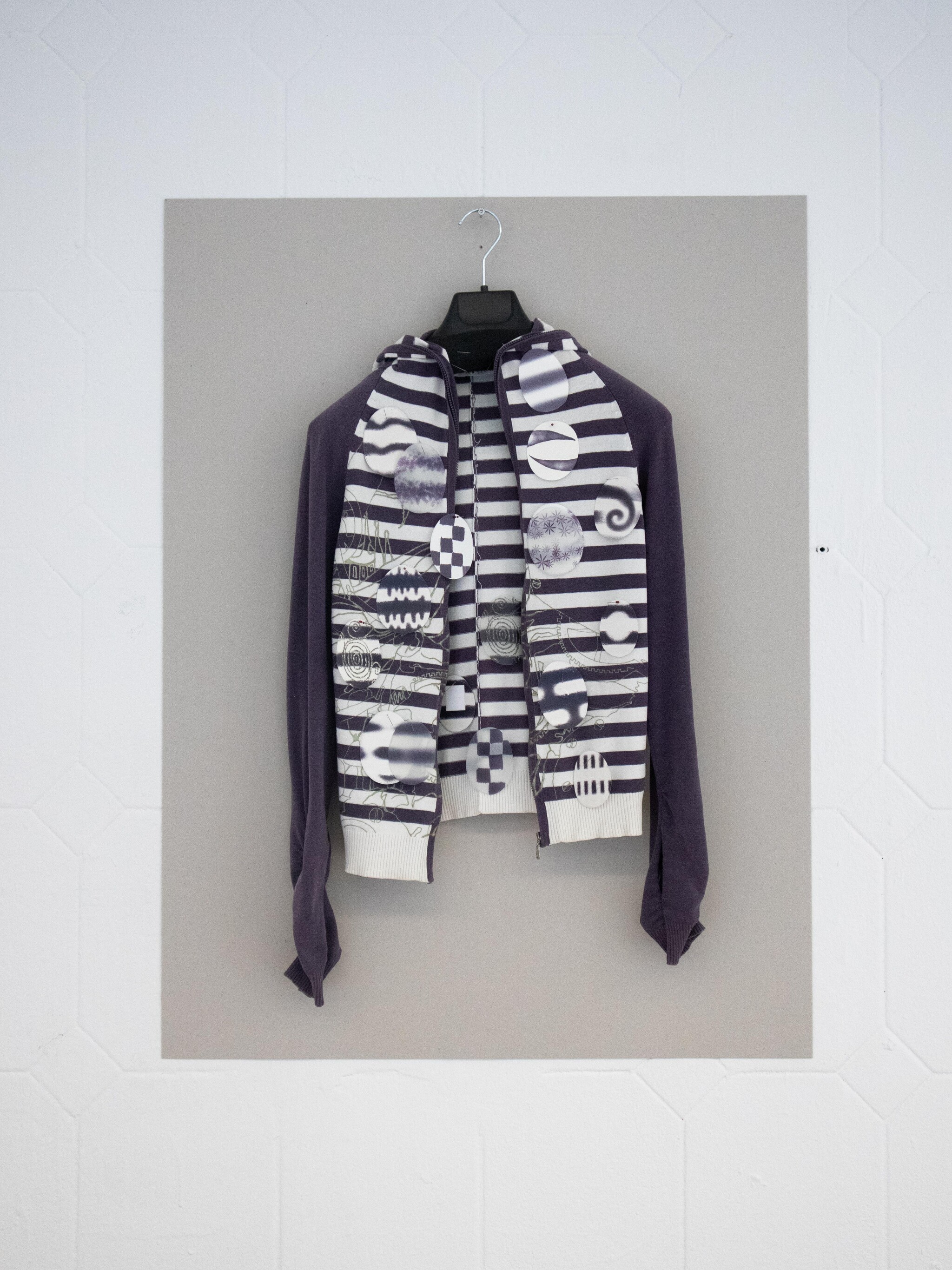
Cutting letters from second-hand children’s clothes I’ve collected, and stitched them into slogans on small flags.
While listening to a podcast, I heard they use the term homonationalism to justify massacres in the Middle East. For some reason, it suddenly reminded me of transphobic conservatives in the U.S.—and I thought, could they actually get along with my parents? Maybe even with my uncles who curse America every day? Especially now, when the relationship between China and the U.S. is so delicate... That’s when I started thinking about slogans again—like “One Planet” or “Workers of the World, Unite.”
In the wake of the collapse of globalization as a fantasy, I wanted to respond with a kind of joke—to mourn that lost dream of a beautifully interconnected world.
Out of the ruins of internationalism and cosmopolitanism, At the same time, the exposure of trauma becomes a form of self-mockery, and also a quiet act of reaffirmation.
Alle Rechte vorbehalten Patricia Black
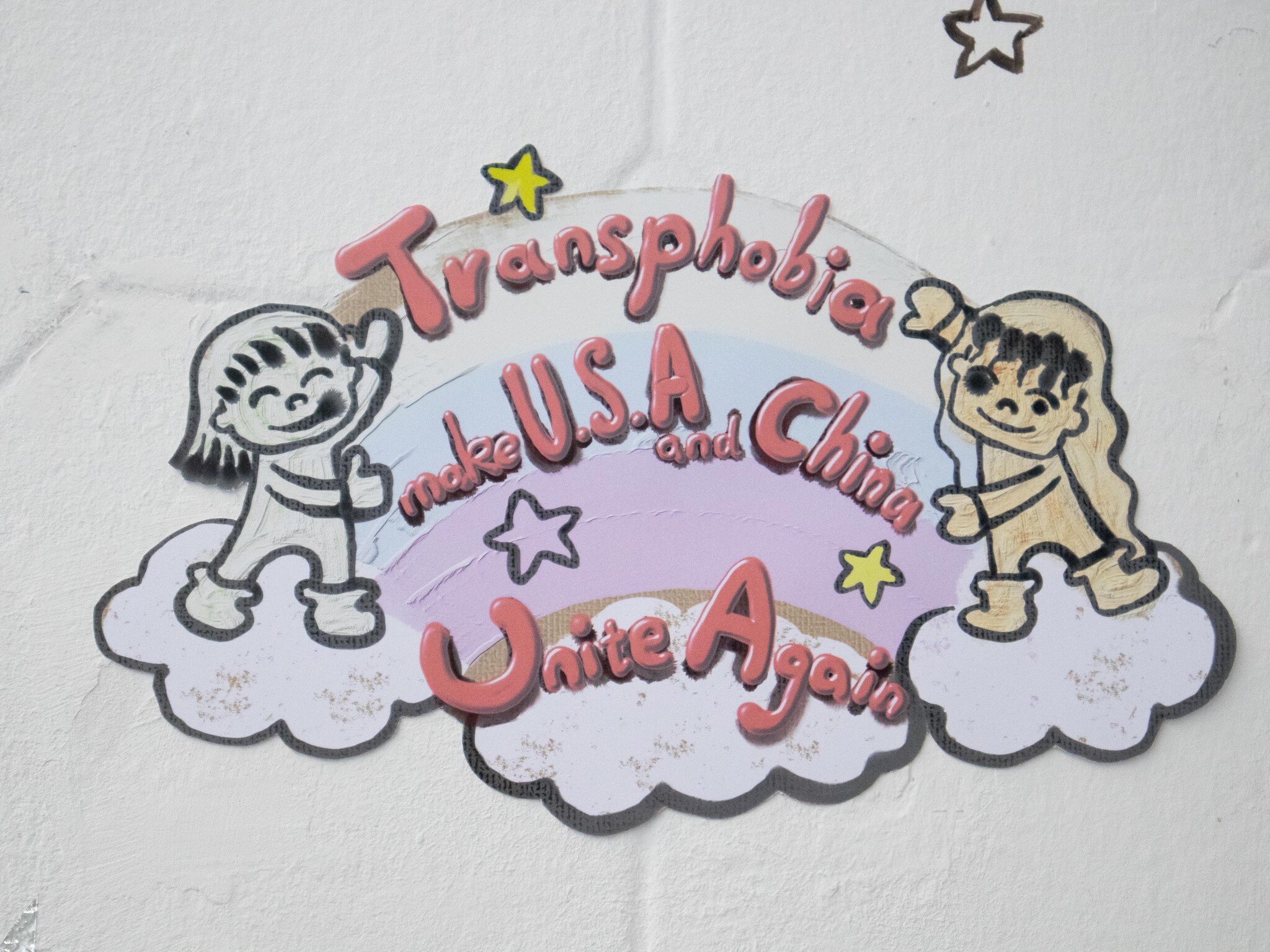
Cutting letters from second-hand children’s clothes I’ve collected, and stitched them into slogans on small flags.
While listening to a podcast, I heard they use the term homonationalism to justify massacres in the Middle East. For some reason, it suddenly reminded me of transphobic conservatives in the U.S.—and I thought, could they actually get along with my parents? Maybe even with my uncles who curse America every day? Especially now, when the relationship between China and the U.S. is so delicate... That’s when I started thinking about slogans again—like “One Planet” or “Workers of the World, Unite.”
In the wake of the collapse of globalization as a fantasy, I wanted to respond with a kind of joke—to mourn that lost dream of a beautifully interconnected world.
Out of the ruins of internationalism and cosmopolitanism, At the same time, the exposure of trauma becomes a form of self-mockery, and also a quiet act of reaffirmation.
Alle Rechte vorbehalten Patricia Black
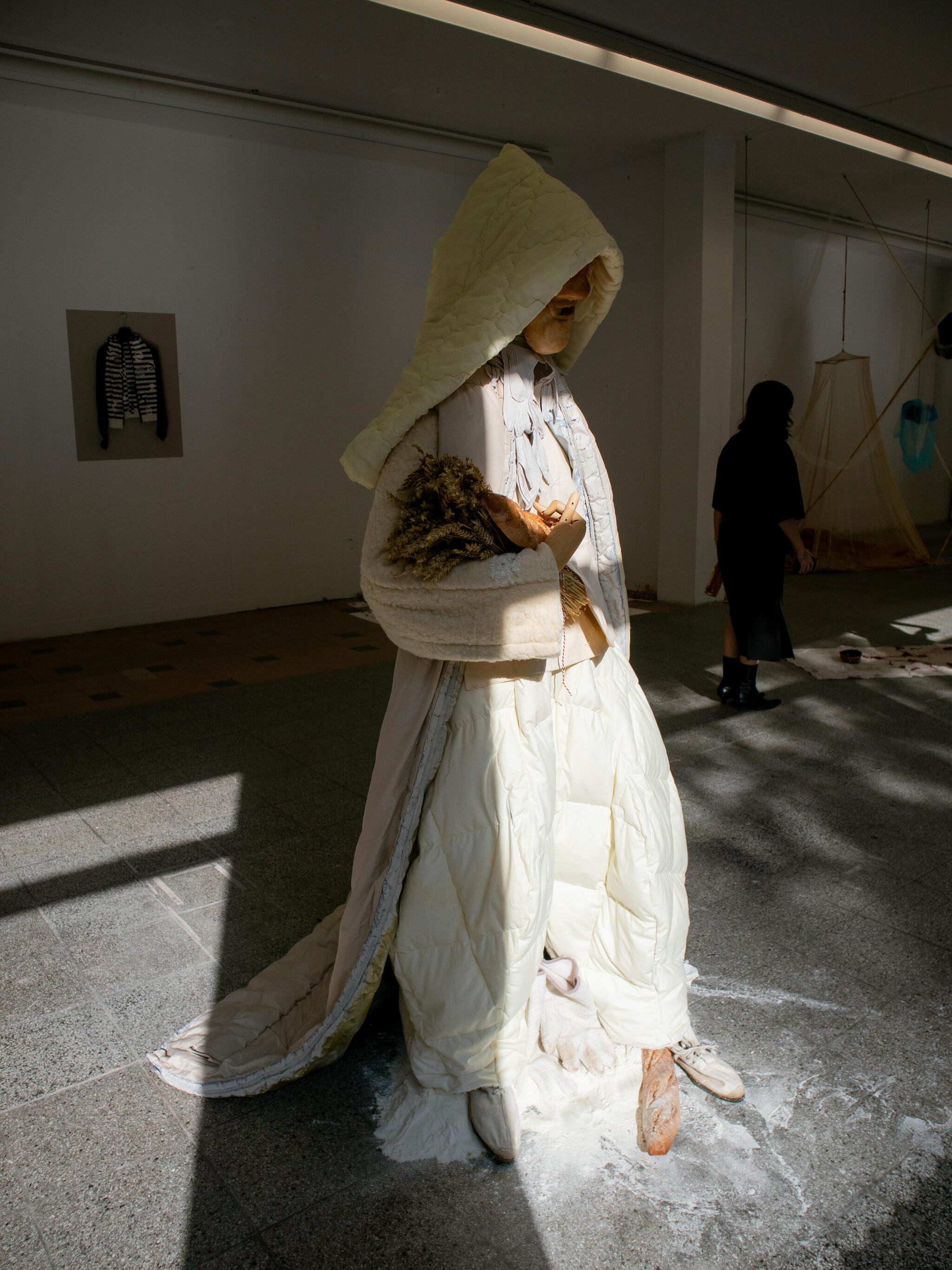
Through breaking bread, The breadman is a figure brought to life both as a fool, patron and herald of Maastricht’s fading Carnival spirit. Maastricht is considered one of the Carnival’s strongholds down in the deep catholic south of the Netherlands. Here, The breadman emerges to form a grotesque body, reanimating the transformative space carnival can be, Embracing, inversion, masquerade and feast.
Carnival takes many forms and shapes globally. Humanity has an ancient bond to metamorphosis. where catholicism reigns it functions as a brief window, an antidote to the constraints of church and communal life: A sanctioned season of topsy-turvy.
The costume and character draws on the site-specific carnivalist dress of the region. Clerical garments were inverted or worn backwards, mocking ecclesiastical authority. From the 19th century onward, discarded bedding and attire served as readymades; collage was a necessity, a way to mask, and expose the ‘inner’ mask.
Today, as masquerade wanes in Maastricht, and its subversive effects shrink, the Breadman arrives, and is animated by another ancient cornerstone of civilization, bread. Bread stands at the threshold between feast and fasting, aligning with carnaval through collective indulgence and delight. Here, panem et circenses is perverted: bread becomes not a pacifier, but awakes the appetite for carnival.
Alle Rechte vorbehalten Patricia Black
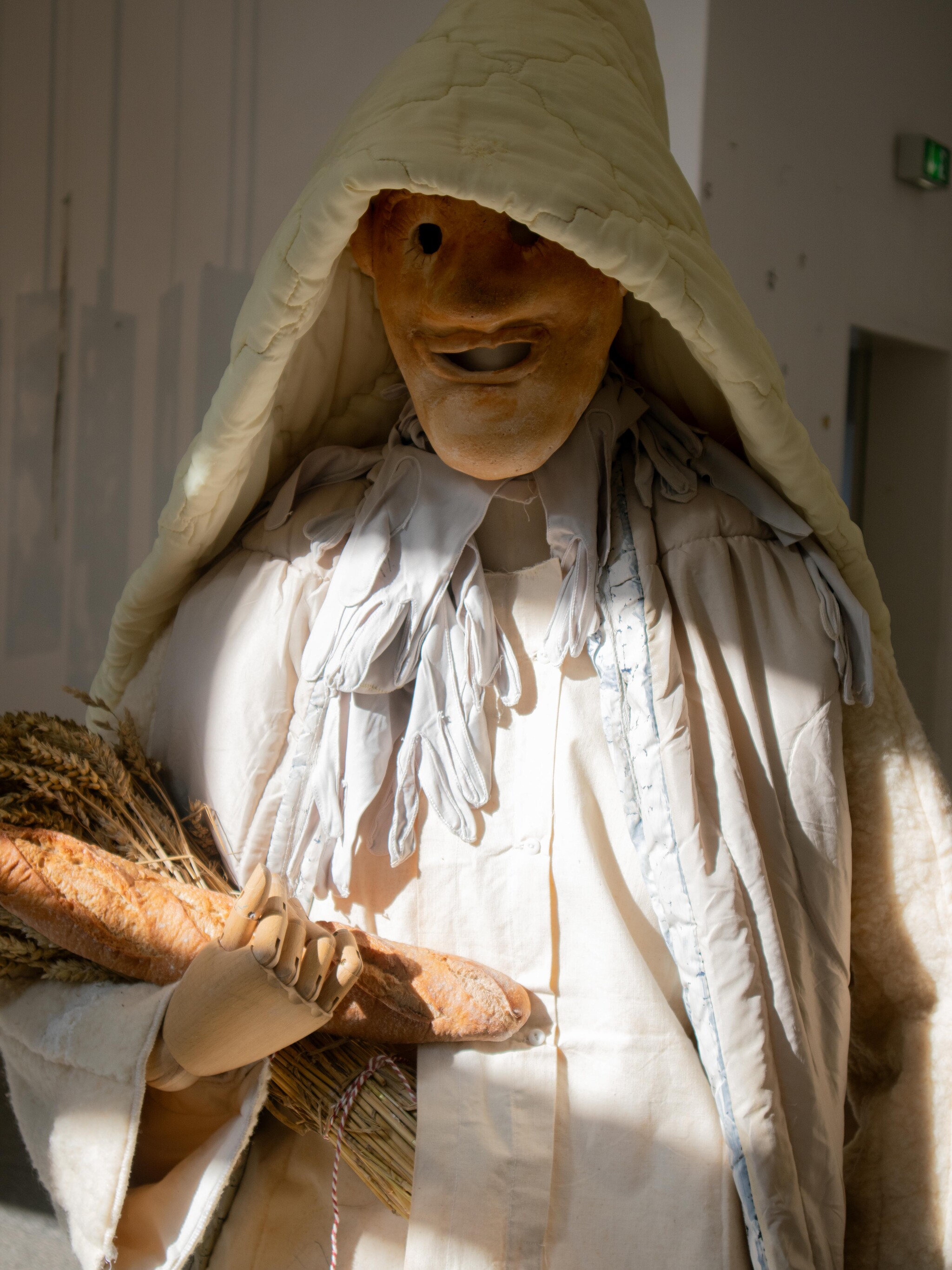
Through breaking bread, The breadman is a figure brought to life both as a fool, patron and herald of Maastricht’s fading Carnival spirit. Maastricht is considered one of the Carnival’s strongholds down in the deep catholic south of the Netherlands. Here, The breadman emerges to form a grotesque body, reanimating the transformative space carnival can be, Embracing, inversion, masquerade and feast.
Carnival takes many forms and shapes globally. Humanity has an ancient bond to metamorphosis. where catholicism reigns it functions as a brief window, an antidote to the constraints of church and communal life: A sanctioned season of topsy-turvy.
The costume and character draws on the site-specific carnivalist dress of the region. Clerical garments were inverted or worn backwards, mocking ecclesiastical authority. From the 19th century onward, discarded bedding and attire served as readymades; collage was a necessity, a way to mask, and expose the ‘inner’ mask.
Today, as masquerade wanes in Maastricht, and its subversive effects shrink, the Breadman arrives, and is animated by another ancient cornerstone of civilization, bread. Bread stands at the threshold between feast and fasting, aligning with carnaval through collective indulgence and delight. Here, panem et circenses is perverted: bread becomes not a pacifier, but awakes the appetite for carnival.
Alle Rechte vorbehalten Patricia Black
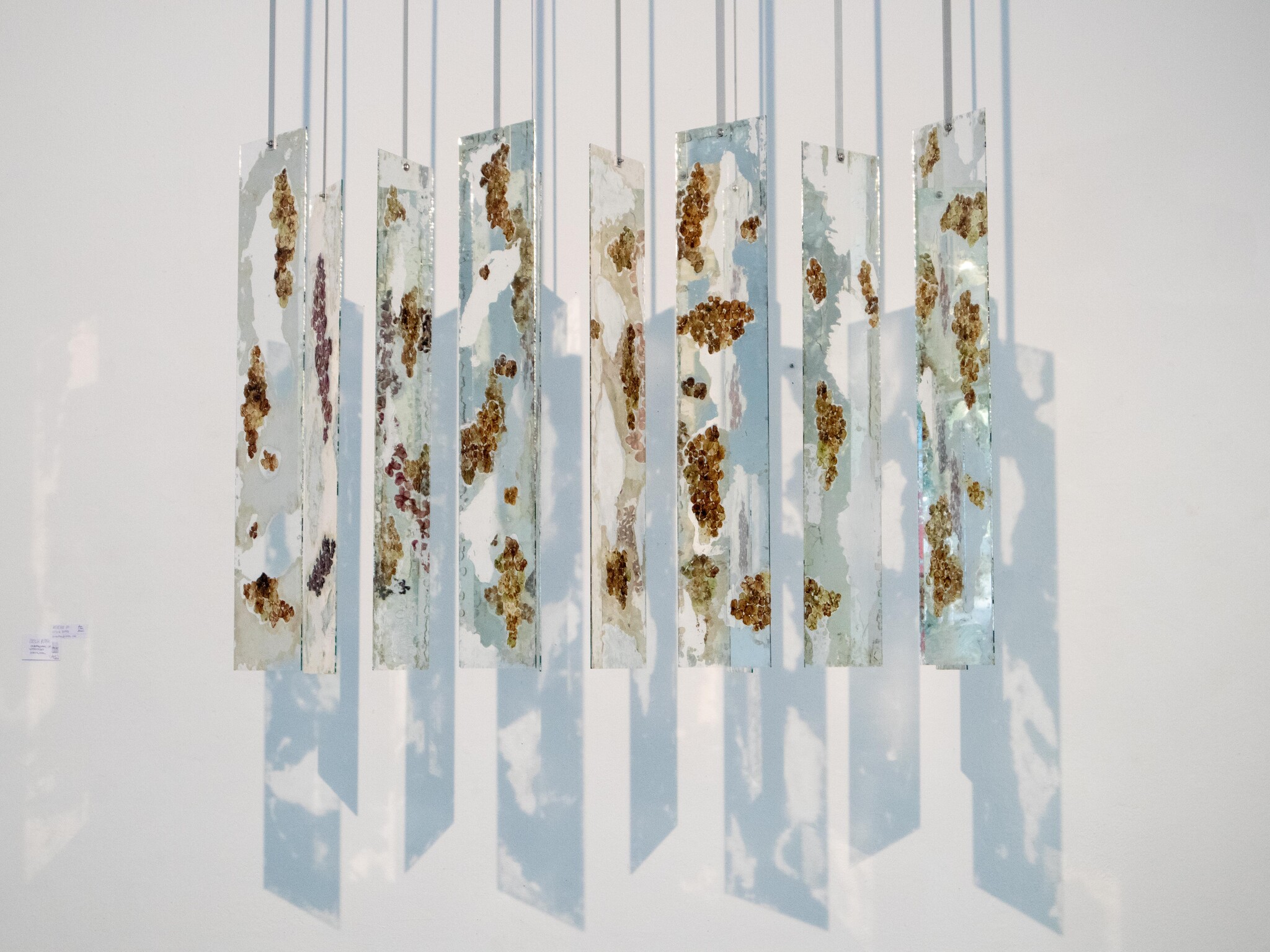
Reverie 01 is an artwork showing an image that doesn’t exist, or rather an image that exists differently in infinite moments: is constantly shape-shifting, ever changing. Its contours are set, yet its reality is undefined, an unclear reflection. It is an endless Doppelgänger: it is always identical as its surroundings, nonetheless its image can never be identically replicated.
Exaggeratedly site-related, calling you in, the artwork is almost constantly unavailable to be captured. It exists only once in every glance, subjectively, in the eyes of the onlooker.
Made of glass and petals that are frozen in their wilting state, the mirrors are made in Venice, according to the oldest traditional and historical way, with liquid silver.
The artisanal way of making mirrors allowed the artist Cecilia to create glitches, imprecisions, where the hand and physical gestures of the artist are revealed. Moments of lack, of emptiness, give way to depth. What can seem like a rupture, a despair, become moments rich of potential: maybe dramatic yes, but begging you to look deeper through them, beyond and behind.
With its disorienting quality, slightly rotating, the spatial artwork asks you to engage and look beneath the surface, beneath what you think is fixed or unchangeable, asks you to relate to its image in a meditative, hallucinating way, with openness and childish curiosity.
The petals - all from poisonous flowers -, the soil belonging to different geographical locations. Yet, everything is here, right now. The wilting flowers frozen in time and the mirrors, the soil and the space that is created, the smooth glass surfaces reminding us of the screens we look at everyday, and you here taking it all in.
The intricacies and complexities of the world, the interconnectedness is here, speaking to us, from beauty to death the minutiae are whispering to us: even when we might be losing hope, there is something alive to hold on to, even if for just one second.
Alle Rechte vorbehalten Patricia Black
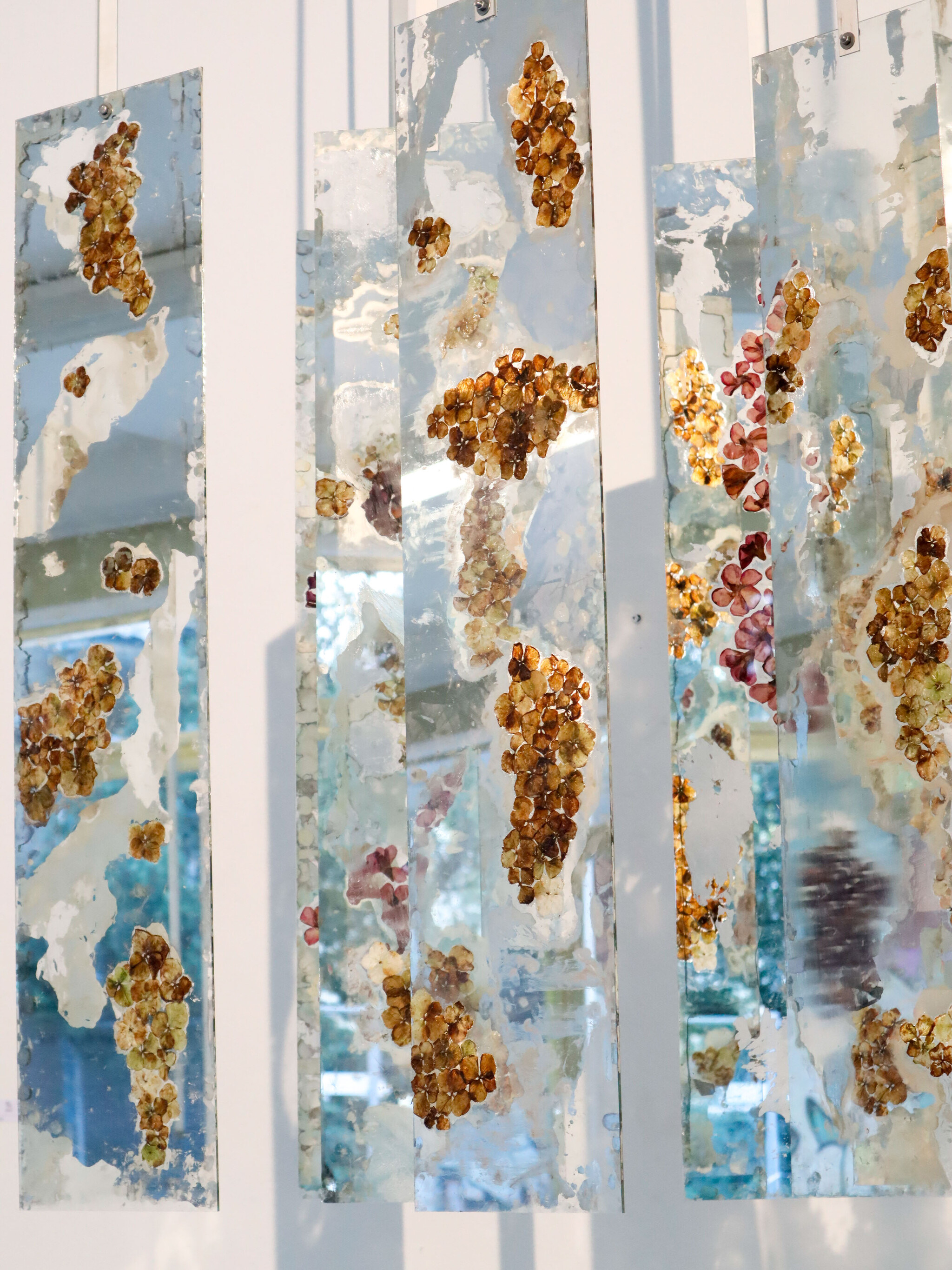
Reverie 01 is an artwork showing an image that doesn’t exist, or rather an image that exists differently in infinite moments: is constantly shape-shifting, ever changing. Its contours are set, yet its reality is undefined, an unclear reflection. It is an endless Doppelgänger: it is always identical as its surroundings, nonetheless its image can never be identically replicated.
Exaggeratedly site-related, calling you in, the artwork is almost constantly unavailable to be captured. It exists only once in every glance, subjectively, in the eyes of the onlooker.
Made of glass and petals that are frozen in their wilting state, the mirrors are made in Venice, according to the oldest traditional and historical way, with liquid silver.
The artisanal way of making mirrors allowed the artist Cecilia to create glitches, imprecisions, where the hand and physical gestures of the artist are revealed. Moments of lack, of emptiness, give way to depth. What can seem like a rupture, a despair, become moments rich of potential: maybe dramatic yes, but begging you to look deeper through them, beyond and behind.
With its disorienting quality, slightly rotating, the spatial artwork asks you to engage and look beneath the surface, beneath what you think is fixed or unchangeable, asks you to relate to its image in a meditative, hallucinating way, with openness and childish curiosity.
The petals - all from poisonous flowers -, the soil belonging to different geographical locations. Yet, everything is here, right now. The wilting flowers frozen in time and the mirrors, the soil and the space that is created, the smooth glass surfaces reminding us of the screens we look at everyday, and you here taking it all in.
The intricacies and complexities of the world, the interconnectedness is here, speaking to us, from beauty to death the minutiae are whispering to us: even when we might be losing hope, there is something alive to hold on to, even if for just one second.
Alle Rechte vorbehalten Patricia Black
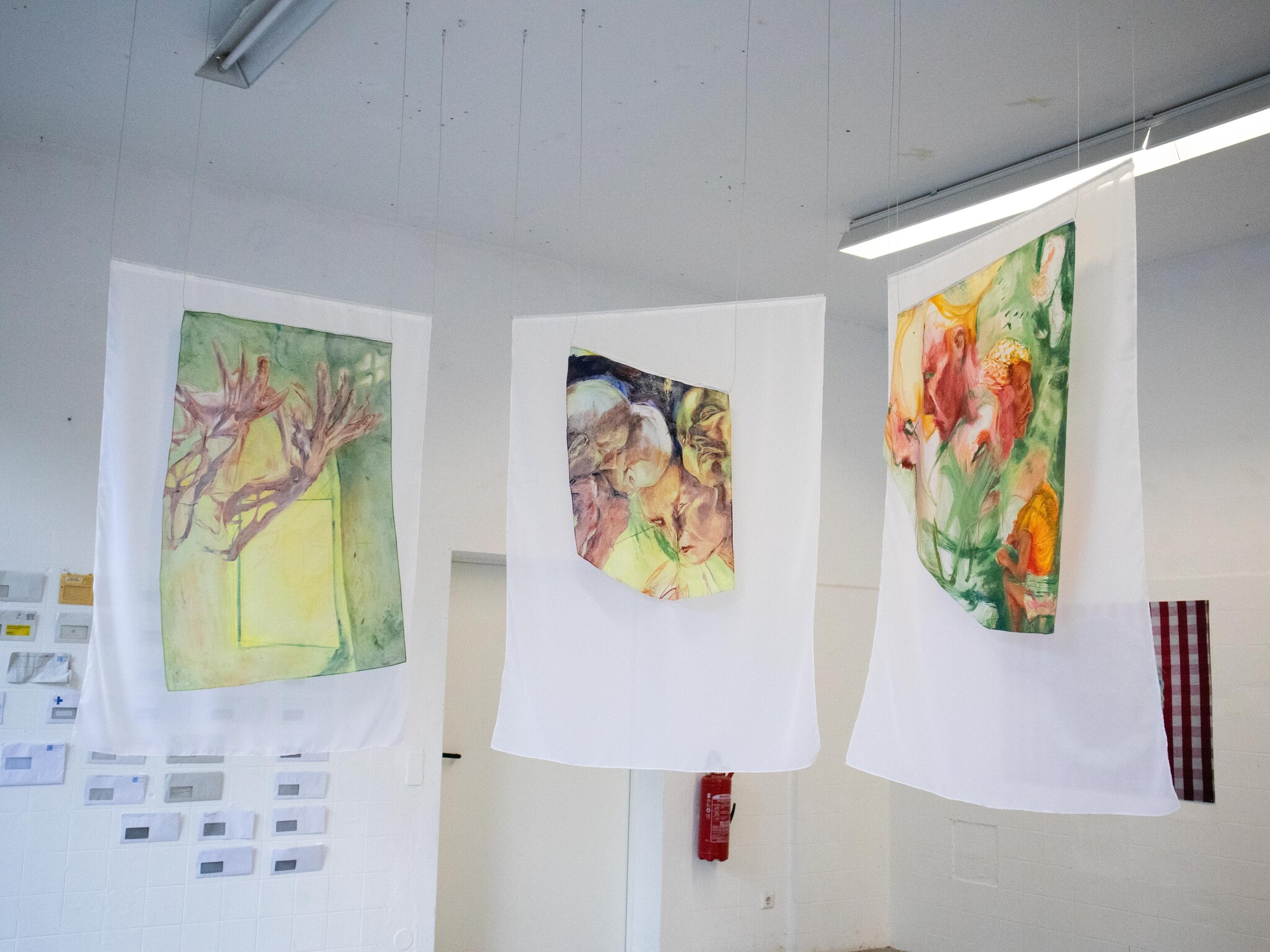
Letters to my friend*s is an ongoing experimental painting series that emerged from visual research and live-painting sessions conducted during the mixed-media project Al Zamakan. This foundational work was developed in residency at Theatre Neben dem Turm, Marburg, with support from the Flausen+ Stipendium program of the Bundesverbands Freie Darstellende Künste e.V.
The paintings originate from a collaborative exploration with video artist Ghazal Alhamwi, examining embodied experiences of time and space within institutional waiting-rooms—spaces that impose particular pressures on diasporic bodies. Through developed scores of repeated movements and breathing patterns, the artists created a non-verbal communication language that guided live-filming sessions. These filmed sequences were projected onto raw canvas and painted in real-time, establishing the foundational sketches and visual vocabulary for the Letters to my friend*s series.
The live-painting process created works of shared authorship, where both filmed and painted images carry collective intention. Since 2024, MN Reyna has continued developing these paintings and their installation contexts, expanding the series from its collaborative origins into an evolving body of work that maintains the embodied research at its core.
The paintings are executed on raw, unprimed semi-transparent textile using diluted oil pigments that stain the fiber directly. Originally a single continuous plane, the textile was cut into specific forms as each work developed. The paintings remain unstretched, existing as flexible, permeable objects whose color, texture, and luminosity shift according to lighting and spatial positioning, functioning simultaneously as image and sculptural presence.
Alle Rechte vorbehalten Patricia Black
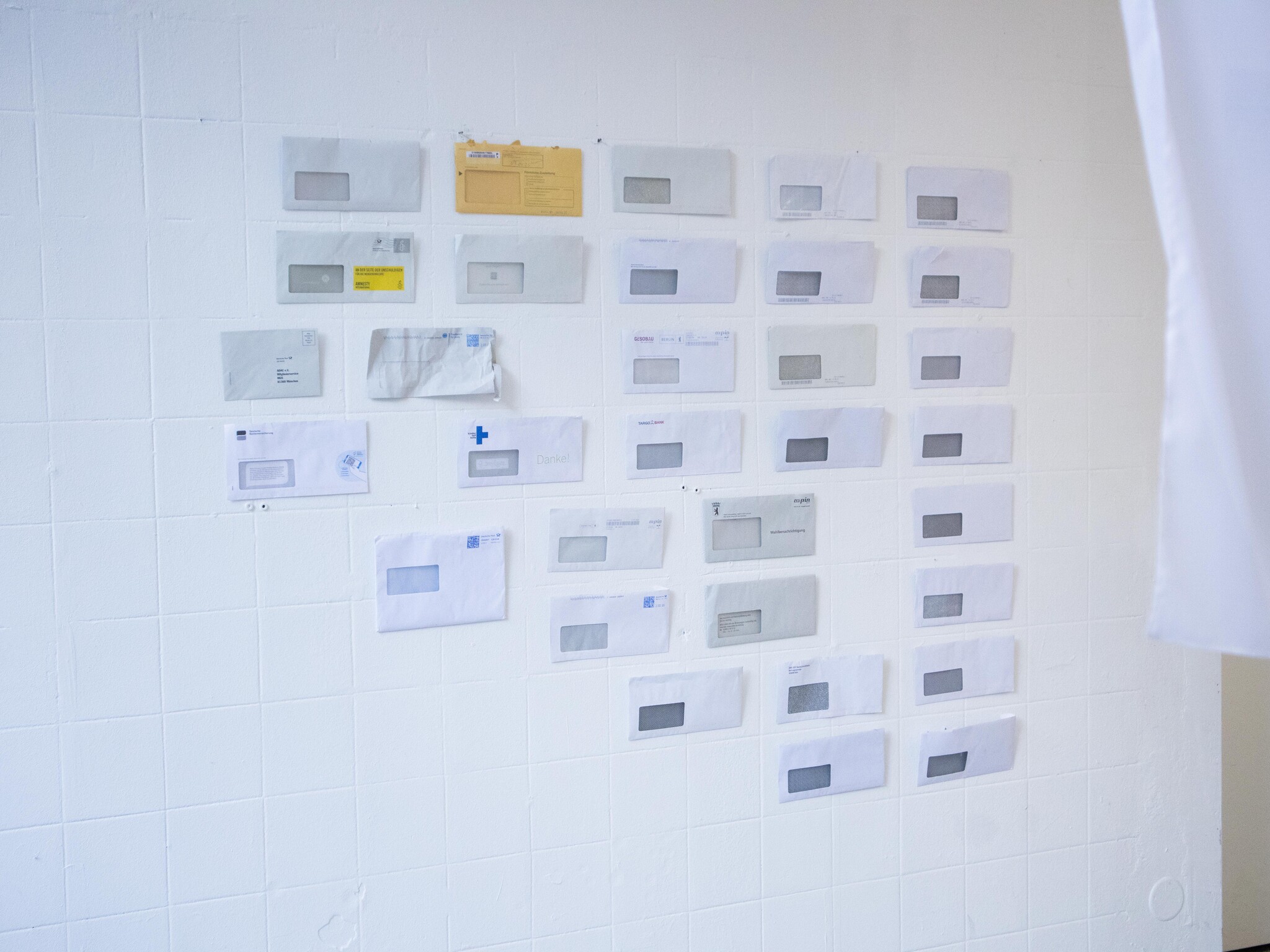
Letters to my friend*s is an ongoing experimental painting series that emerged from visual research and live-painting sessions conducted during the mixed-media project Al Zamakan. This foundational work was developed in residency at Theatre Neben dem Turm, Marburg, with support from the Flausen+ Stipendium program of the Bundesverbands Freie Darstellende Künste e.V.
The paintings originate from a collaborative exploration with video artist Ghazal Alhamwi, examining embodied experiences of time and space within institutional waiting-rooms—spaces that impose particular pressures on diasporic bodies. Through developed scores of repeated movements and breathing patterns, the artists created a non-verbal communication language that guided live-filming sessions. These filmed sequences were projected onto raw canvas and painted in real-time, establishing the foundational sketches and visual vocabulary for the Letters to my friend*s series.
The live-painting process created works of shared authorship, where both filmed and painted images carry collective intention. Since 2024, MN Reyna has continued developing these paintings and their installation contexts, expanding the series from its collaborative origins into an evolving body of work that maintains the embodied research at its core.
The paintings are executed on raw, unprimed semi-transparent textile using diluted oil pigments that stain the fiber directly. Originally a single continuous plane, the textile was cut into specific forms as each work developed. The paintings remain unstretched, existing as flexible, permeable objects whose color, texture, and luminosity shift according to lighting and spatial positioning, functioning simultaneously as image and sculptural presence.
Alle Rechte vorbehalten Patricia Black
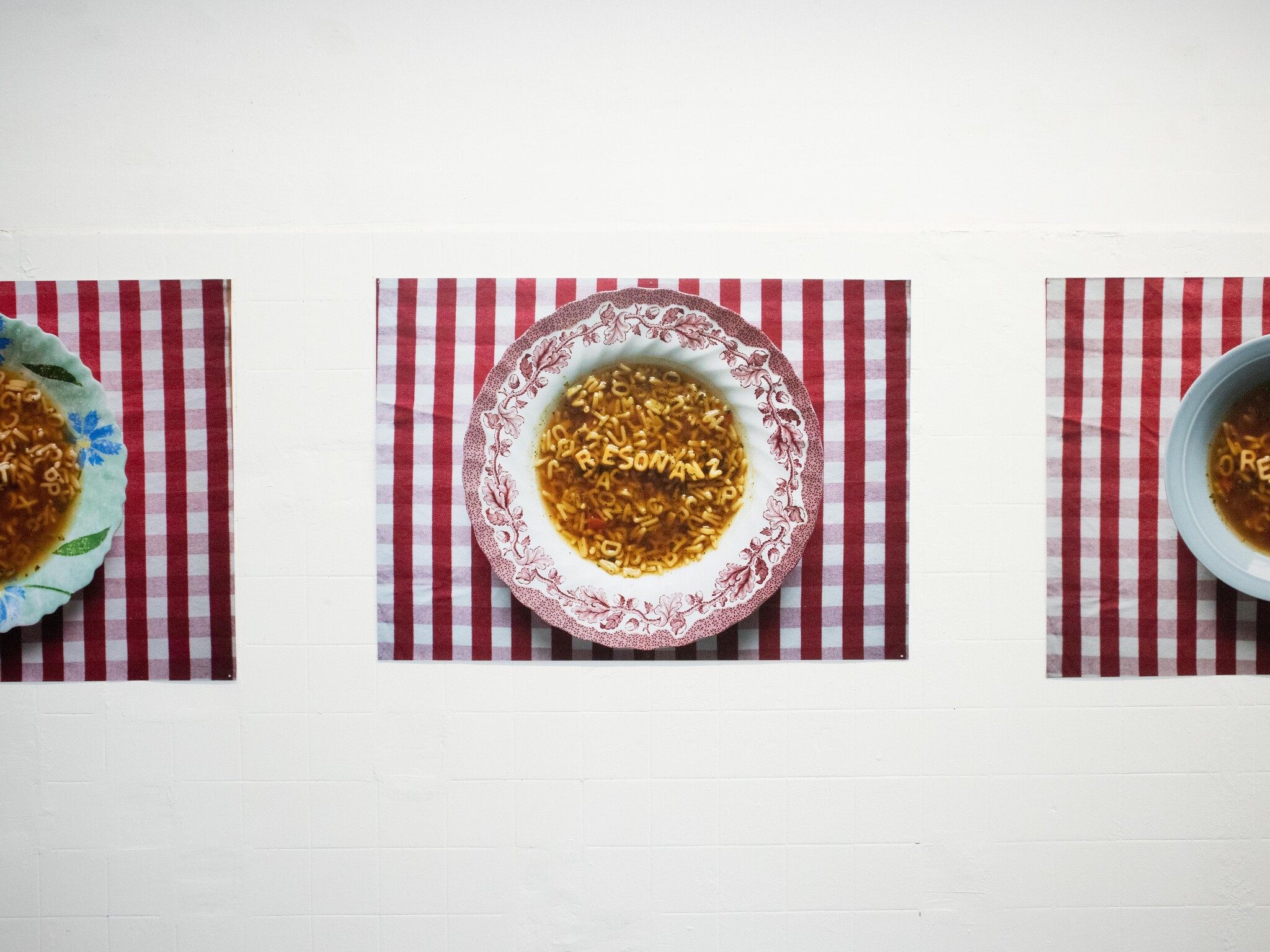
Alle Rechte vorbehalten Patricia Black
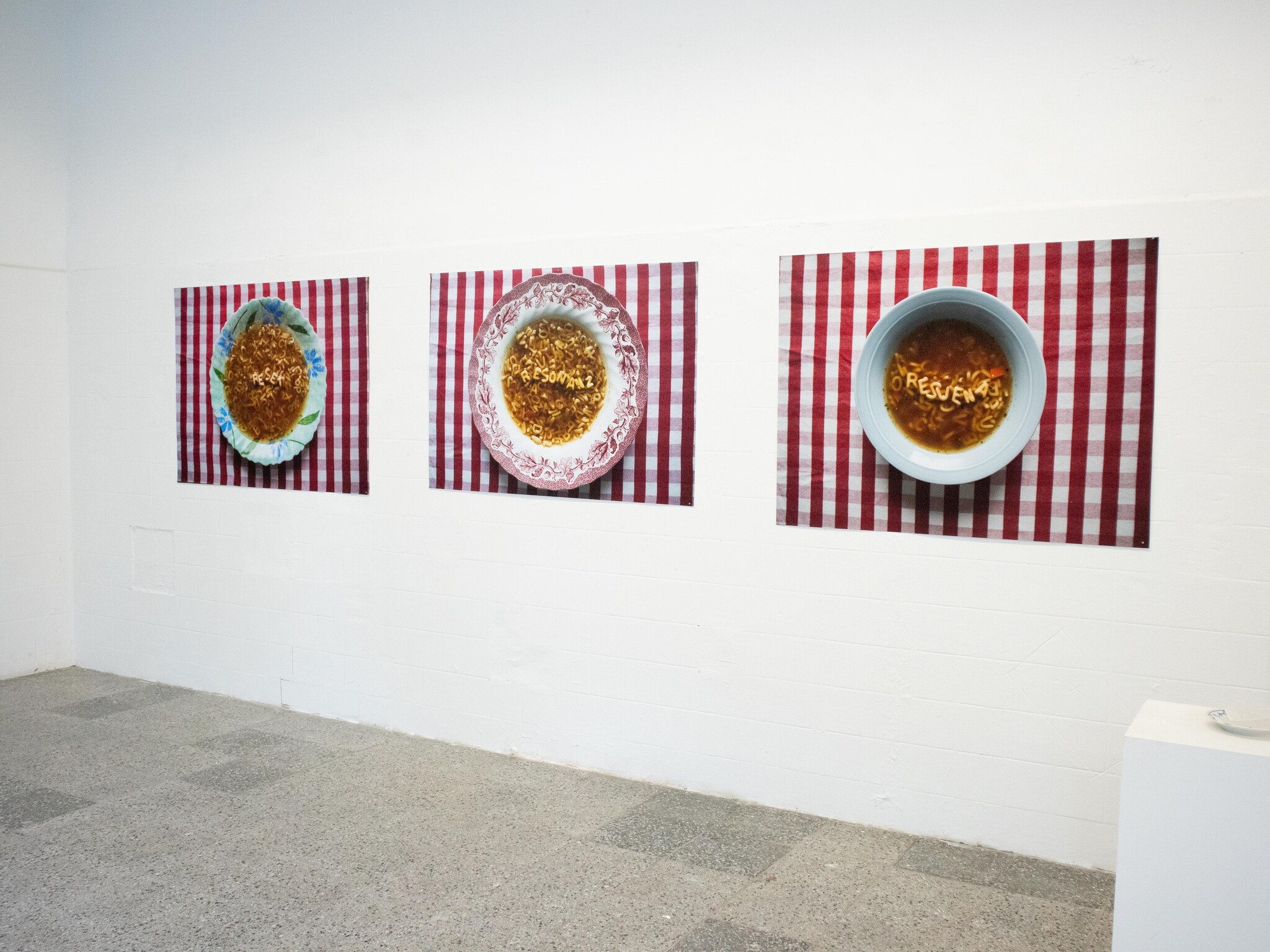
Alle Rechte vorbehalten Patricia Black
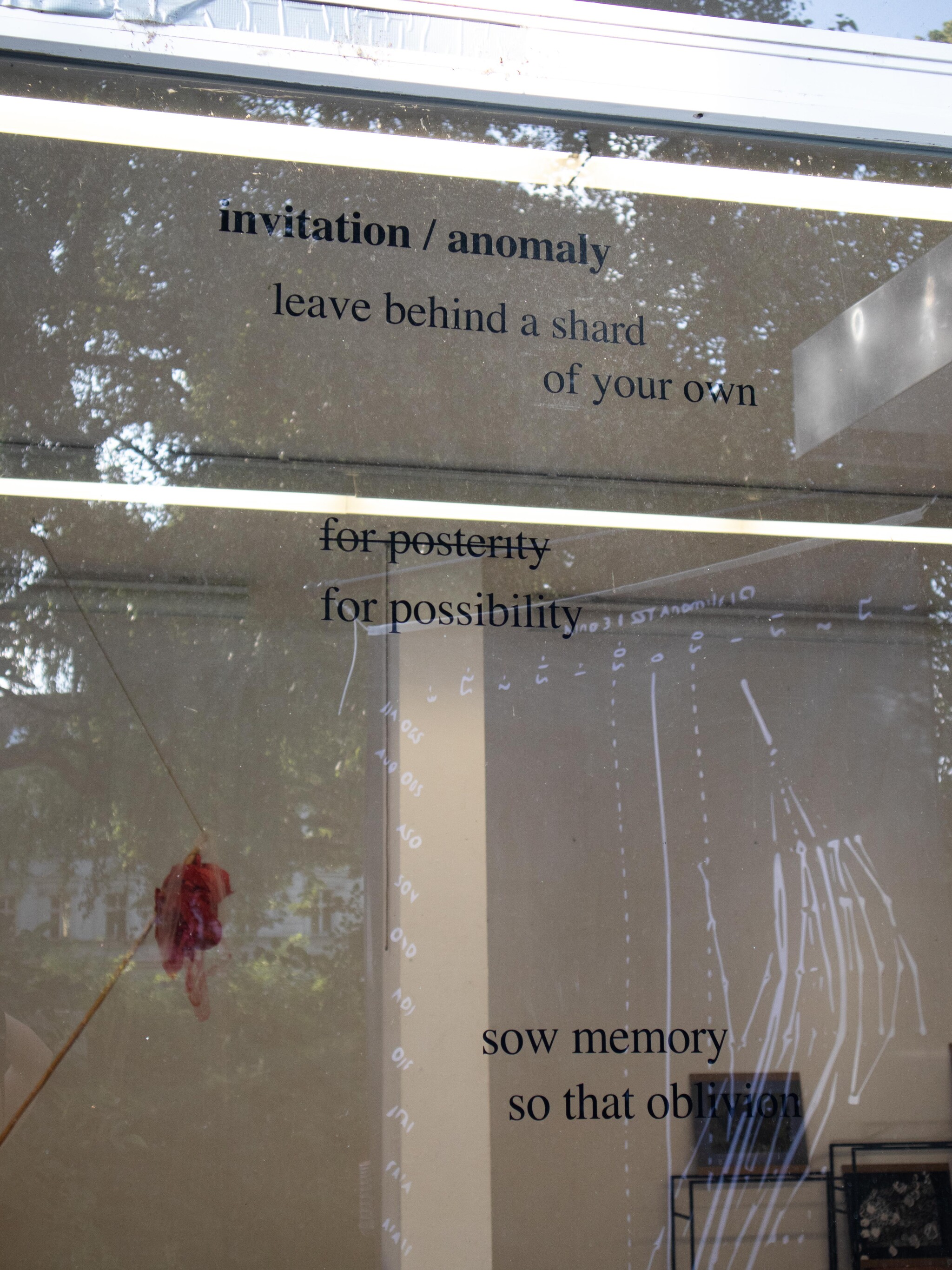
Alle Rechte vorbehalten Patricia Black
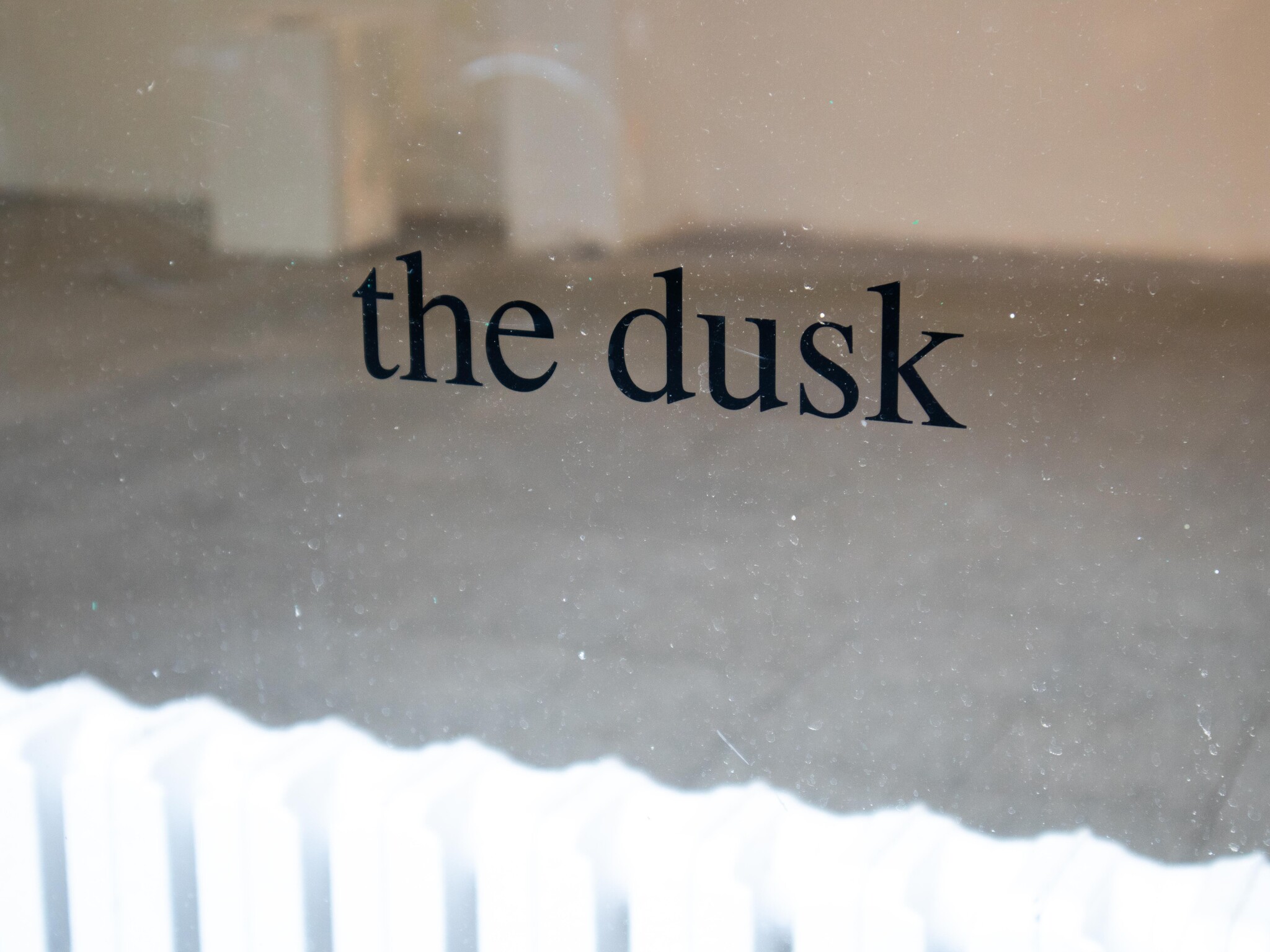
Alle Rechte vorbehalten Patricia Black
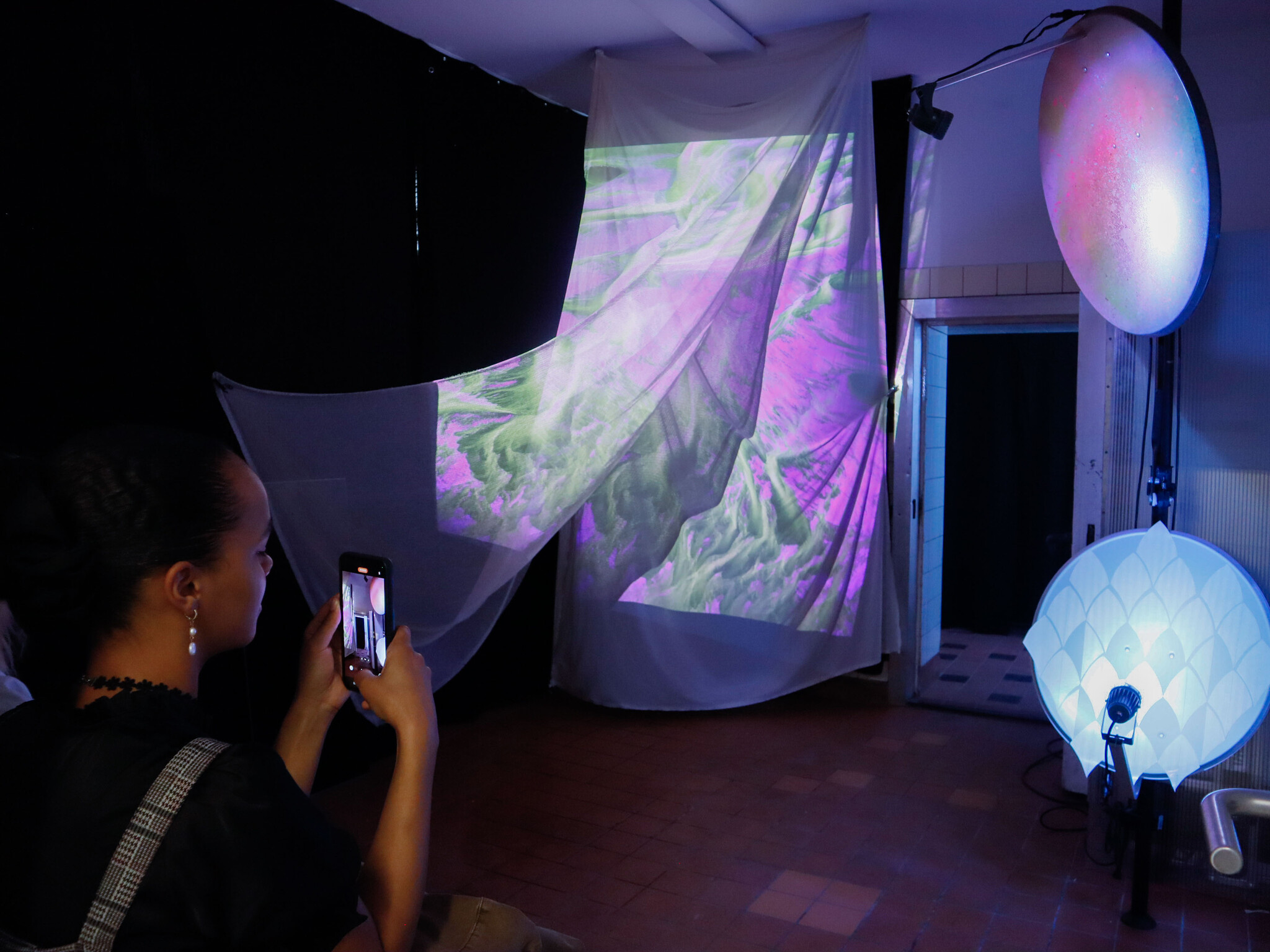
The mixed media installation ‘Transitions,’ explores artistically and critically the transition from one state to another. It is speculatively represented in social, geomorphological, ecological, and psychological terms: the colonial transition to modern times. The transition from warm to cold air. The formation of fog. Disorientation. Letting go? The transition from a place to another one. Uncertainty? The transition of information between transmitter and receiver. The fluid transition of different natural systems at a river delta.
The exhibition brainstorms with various transition systems and invites visitors to read them as intertwined.
Alle Rechte vorbehalten Patricia Black
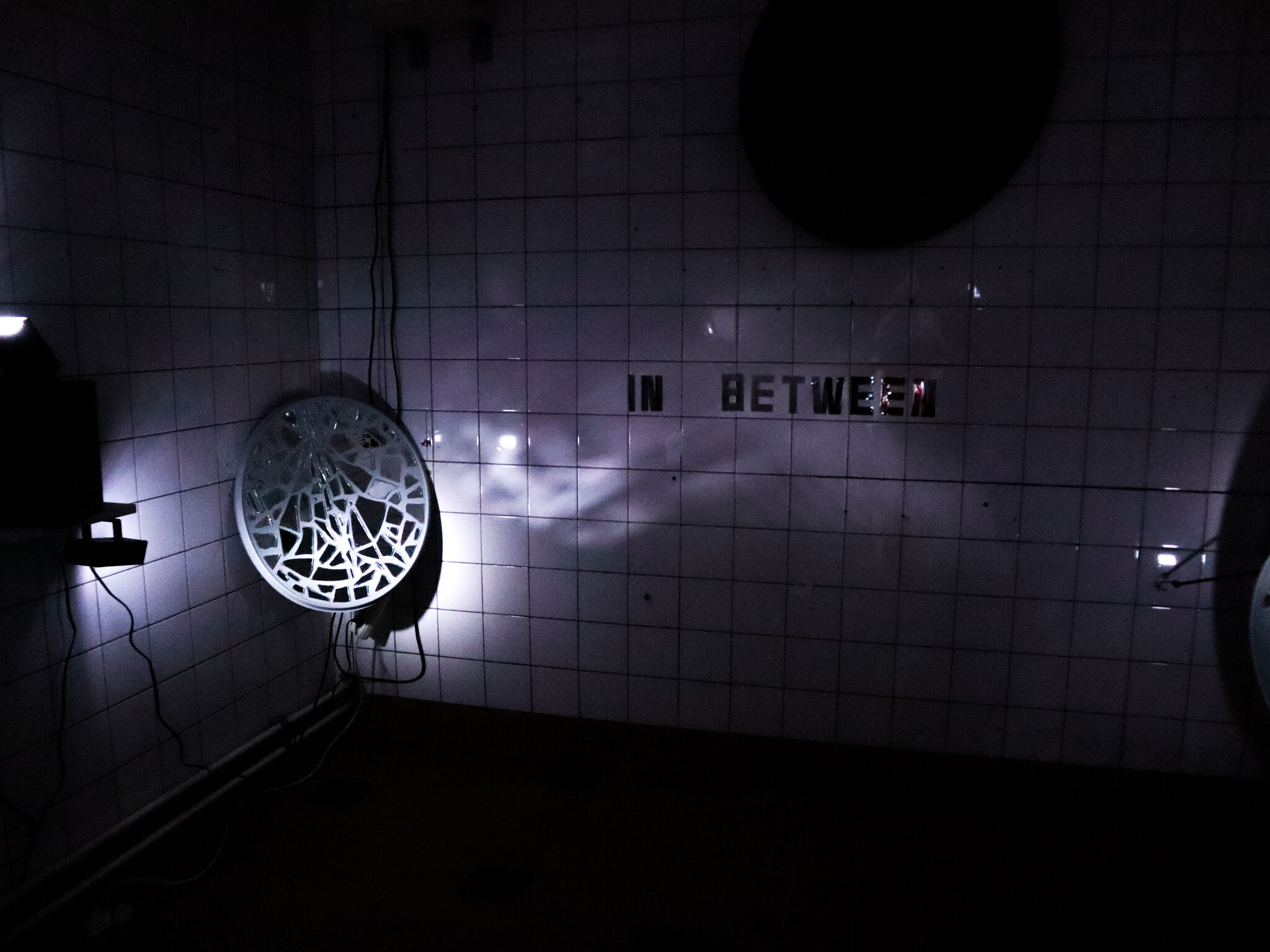
The mixed media installation ‘Transitions,’ explores artistically and critically the transition from one state to another. It is speculatively represented in social, geomorphological, ecological, and psychological terms: the colonial transition to modern times. The transition from warm to cold air. The formation of fog. Disorientation. Letting go? The transition from a place to another one. Uncertainty? The transition of information between transmitter and receiver. The fluid transition of different natural systems at a river delta.
The exhibition brainstorms with various transition systems and invites visitors to read them as intertwined.
Alle Rechte vorbehalten Patricia Black
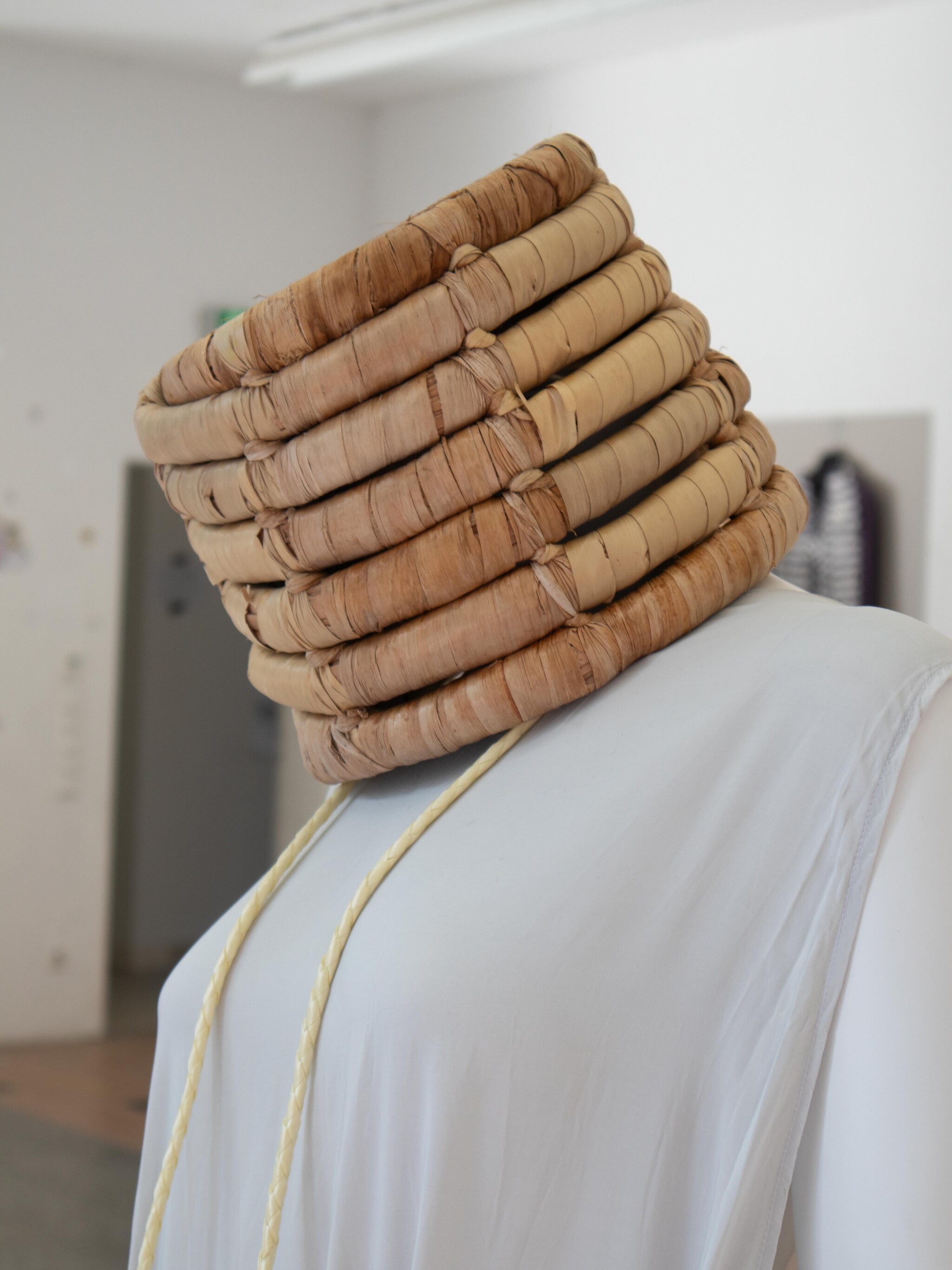
With the foundations of 'Ubuntu' as a philosophy and as open-source technology, three sister seeds wonder how humans and they can coexist in rapid biotechnology changes ?
Alle Rechte vorbehalten Patricia Black
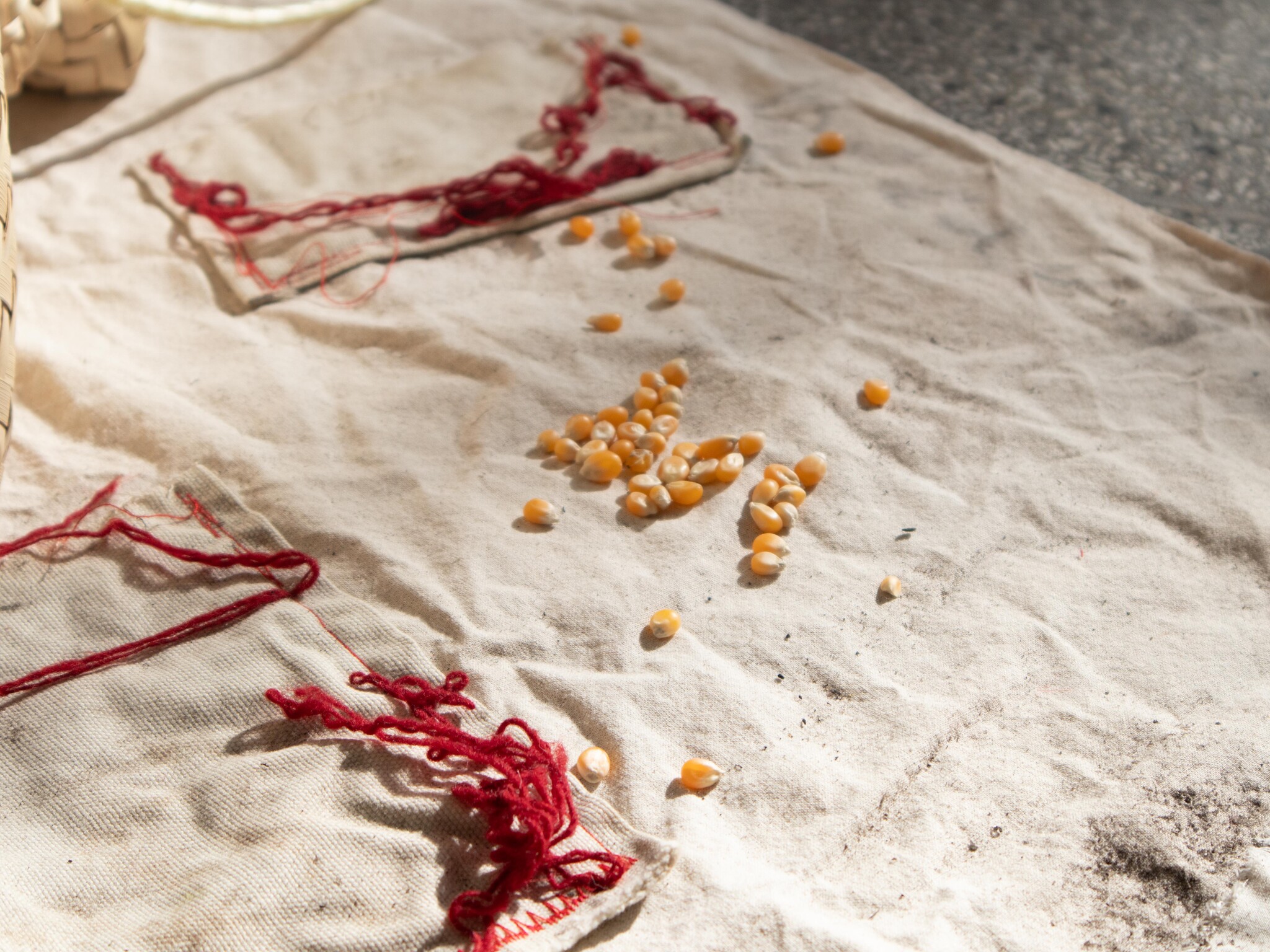
Video performance, Floating University.
3 costume pieces, installation.
Performance and costumes by:
Yupanqui Ramos.
Performing in collaboration with:
Anne Nascimiento and Araike da Silva
Video documentation: Patricia Black
and Pedro André
With the foundations of 'Ubuntu' as a philosophy and as open-source technology, three sister seeds wonder how humans and they can coexist in rapid biotechnology changes ?
Alle Rechte vorbehalten Patricia Black
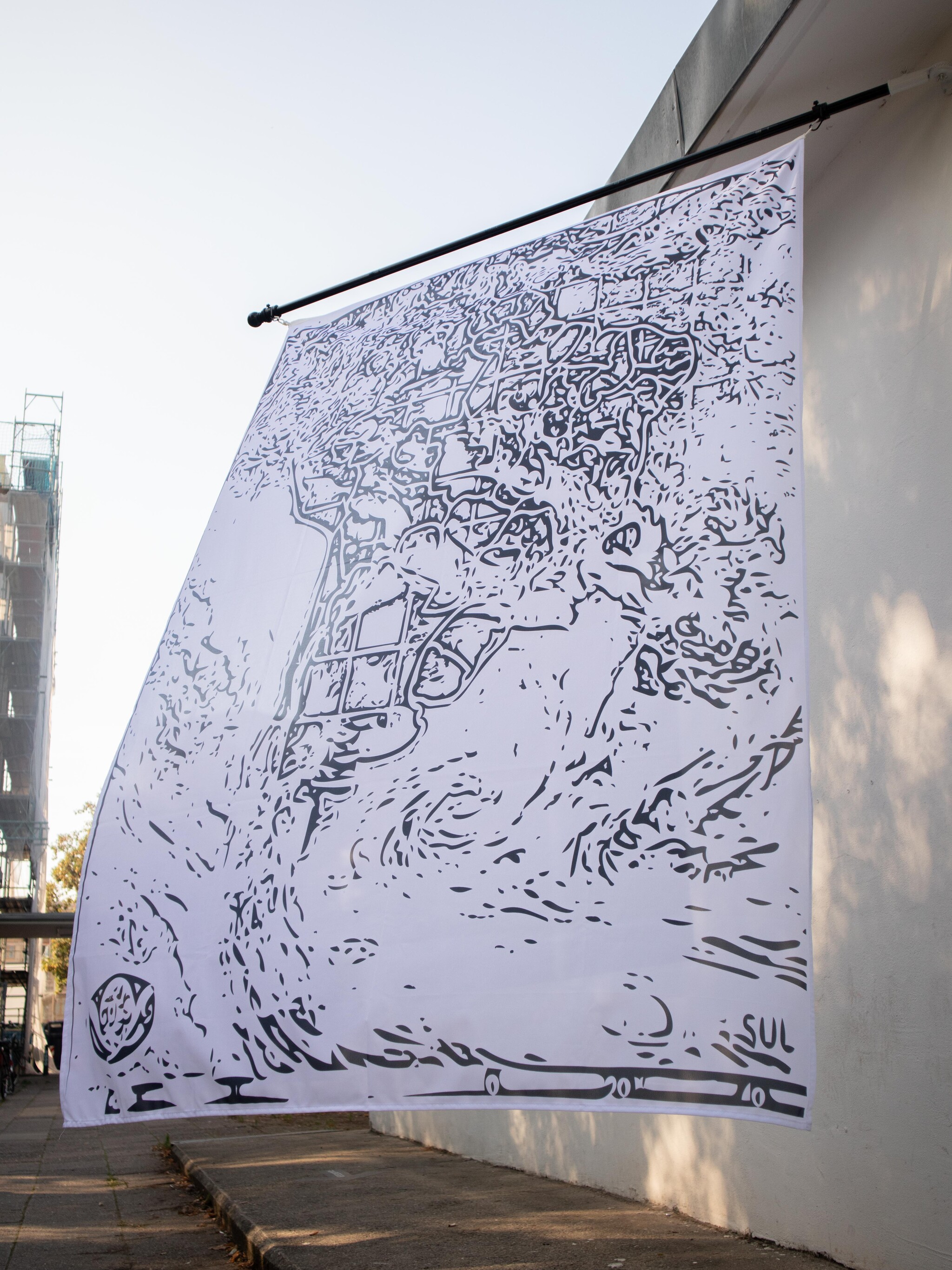
there be dragons is an ad infinutum series of flags that document and follow recent storm patterns
in the south of Brazil. Each of its diagrams is a translation of different weather maps, and their encompassing set of statistics, into an unknown other-worldly language.
The series’ title points referenceto the work of the Dutch artist Sef Peters and his series ‘Hic Sunt Dracones’ (Here Be Dragons). The Latin expression used by Peters was for a long time believed to have originated in the Middle Ages and used to underline uncharted areas in old maps. However, recent research has revealed that the saying was an anachronism, as the original classical phrase used by medieval cartographers was in fact ‘Hic Sunt Leones’ (Here be Lions).
Being the former only seen in a small number of terrestrial globes from the early 1500s, most famously the ‘Hunt Lenox Globe,’ which is also, interestingly, one of the first maps to reference Latin America.
Through the appropriation of this anachronism, the artist reframes and subverts it within the fetishized colonial narrative imposed on Brazil and its history. A place of monsters and mysteries, whose existence surpasses reality and the banal life of Europe’s human landscape.
Although harsh, the artist’s framing is not naive, as it proposes this very land as the utmost desired dream, only truly understood by the ones who from there have come.
Despite posing many of the similar questions regarding Brazil’s relationship with Europe previously seen in the artists practice, ‘there be dragons’ belongs to a brand new series of works that spawn from a larger Lore set in a Post-Humanistic world, where Humans have utilized newly developed AI
Forecasting technology in order to communicate with an atmospheric being named Æther. In this context, the series functions as both relic and prognosis rendering of that contact.
Bespeaking therefore upon the atmosphere of Brazil, a sci-fi signification and existence, whose tactile and visual representation can indicate the future well-being of the planet and its incoming climate doom. Making of that landscape a species of self-aware, self-populated, communicating being. Similar maybe to Tarkovsky’s Ocean.
Alle Rechte vorbehalten Patricia Black
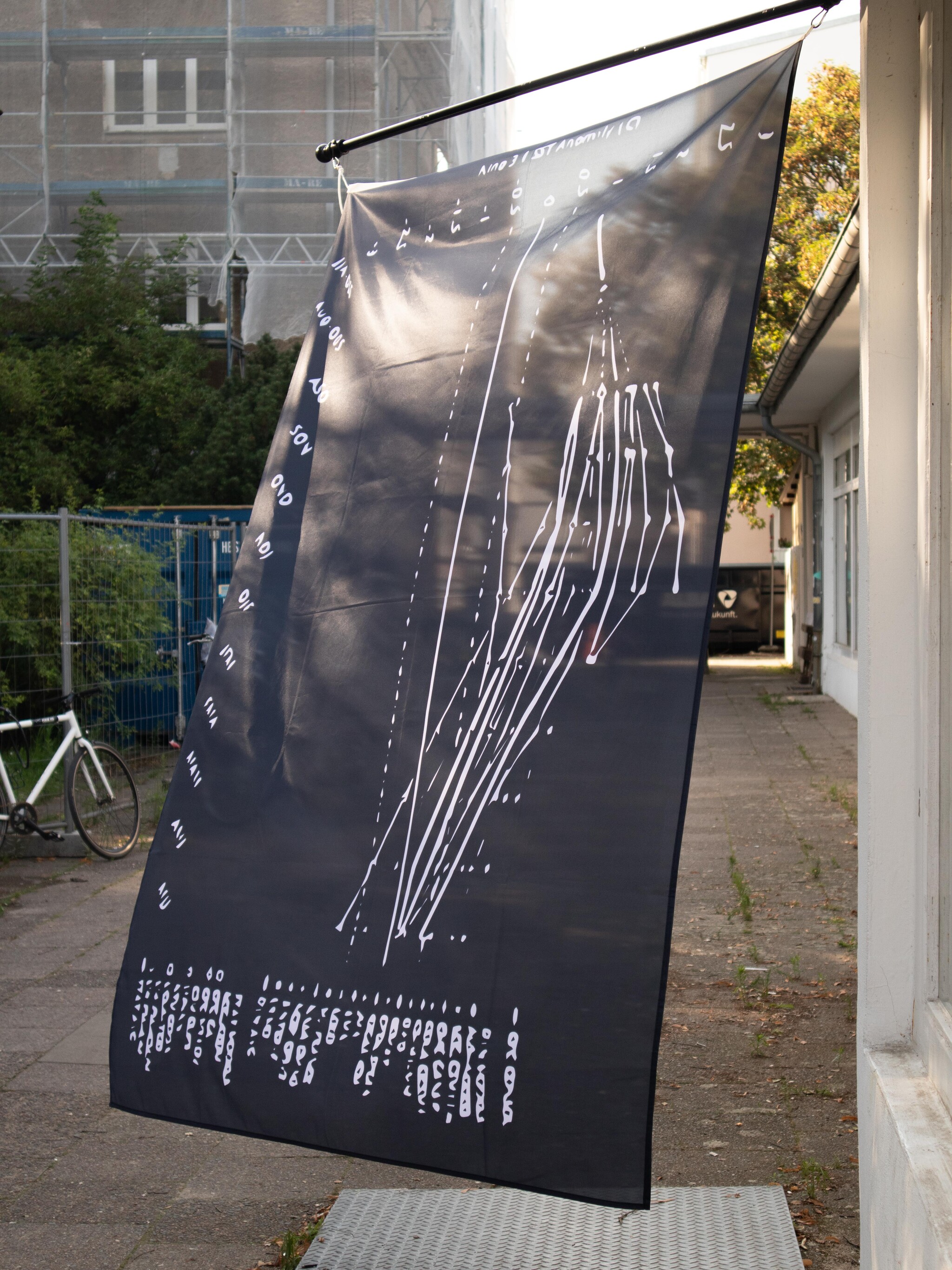
there be dragons is an ad infinutum series of flags that document and follow recent storm patterns
in the south of Brazil. Each of its diagrams is a translation of different weather maps, and their encompassing set of statistics, into an unknown other-worldly language.
The series’ title points referenceto the work of the Dutch artist Sef Peters and his series ‘Hic Sunt Dracones’ (Here Be Dragons). The Latin expression used by Peters was for a long time believed to have originated in the Middle Ages and used to underline uncharted areas in old maps. However, recent research has revealed that the saying was an anachronism, as the original classical phrase used by medieval cartographers was in fact ‘Hic Sunt Leones’ (Here be Lions).
Being the former only seen in a small number of terrestrial globes from the early 1500s, most famously the ‘Hunt Lenox Globe,’ which is also, interestingly, one of the first maps to reference Latin America.
Through the appropriation of this anachronism, the artist reframes and subverts it within the fetishized colonial narrative imposed on Brazil and its history. A place of monsters and mysteries, whose existence surpasses reality and the banal life of Europe’s human landscape.
Although harsh, the artist’s framing is not naive, as it proposes this very land as the utmost desired dream, only truly understood by the ones who from there have come.
Despite posing many of the similar questions regarding Brazil’s relationship with Europe previously seen in the artists practice, ‘there be dragons’ belongs to a brand new series of works that spawn from a larger Lore set in a Post-Humanistic world, where Humans have utilized newly developed AI
Forecasting technology in order to communicate with an atmospheric being named Æther. In this context, the series functions as both relic and prognosis rendering of that contact.
Bespeaking therefore upon the atmosphere of Brazil, a sci-fi signification and existence, whose tactile and visual representation can indicate the future well-being of the planet and its incoming climate doom. Making of that landscape a species of self-aware, self-populated, communicating being. Similar maybe to Tarkovsky’s Ocean.
Alle Rechte vorbehalten Patricia Black
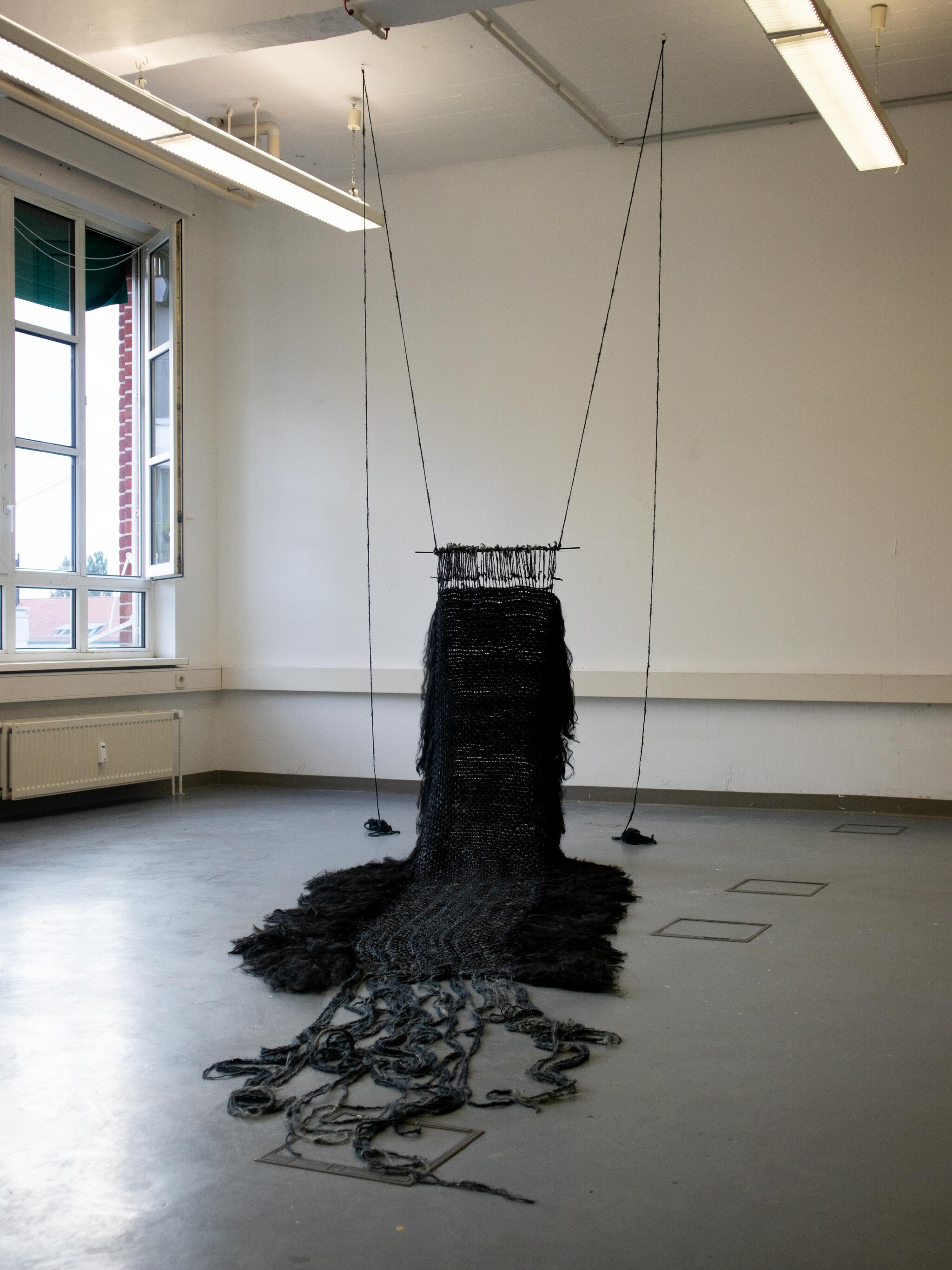
The installation evokes the form of a shelter—ancient yet impermanent. Rooted in the traditions of nomadic life, the woven fabric draws on strategies of movement and survival, reflecting on how we inhabit a world shaped by ecological and political upheaval. Through its tactility, the work becomes a meditation on displacement, resilience, and the possibility of cohabiting with the land—not as owners, but as passing kin.
Alle Rechte vorbehalten Patricia Black
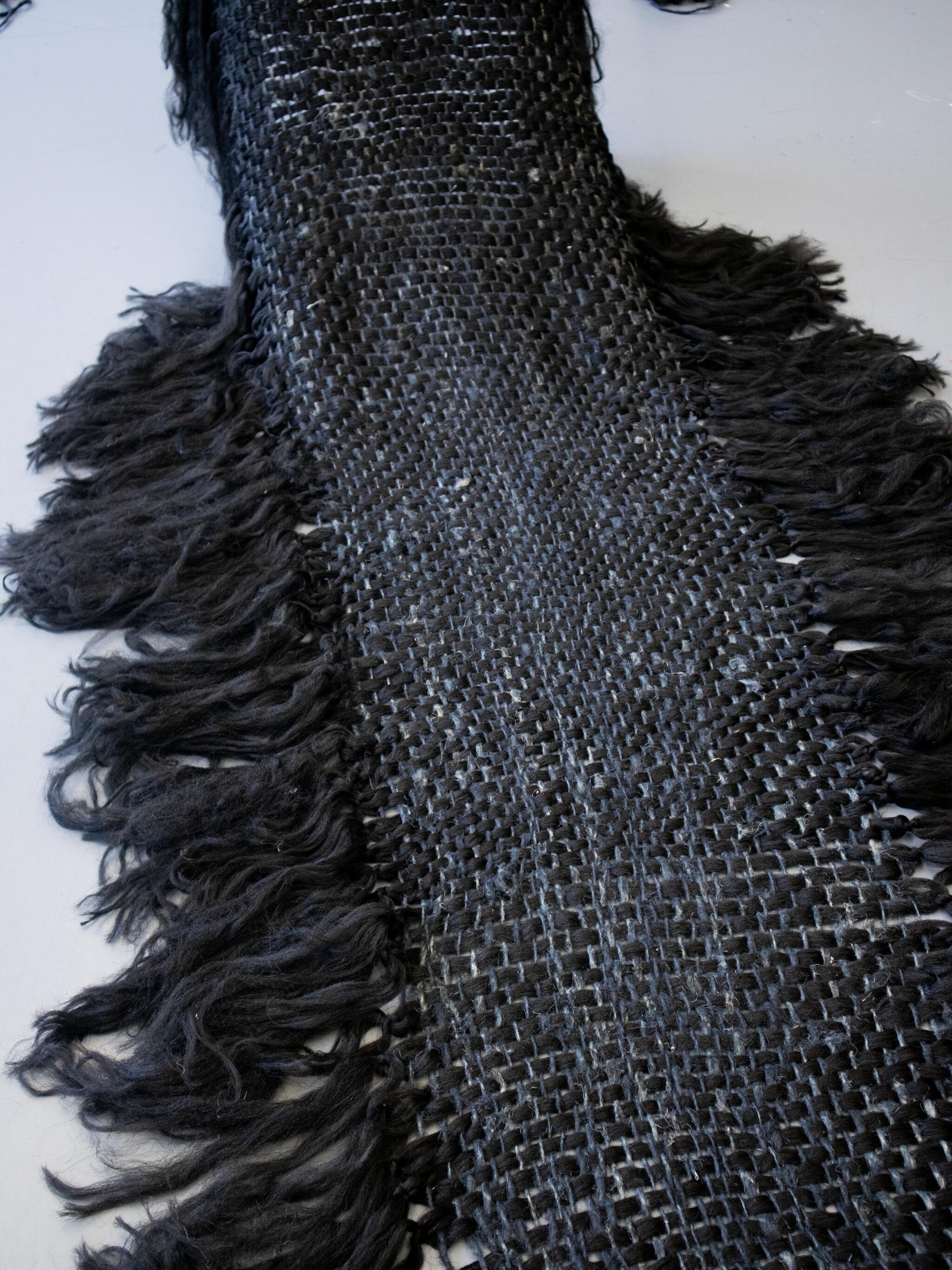
The installation evokes the form of a shelter—ancient yet impermanent. Rooted in the traditions of nomadic life, the woven fabric draws on strategies of movement and survival, reflecting on how we inhabit a world shaped by ecological and political upheaval. Through its tactility, the work becomes a meditation on displacement, resilience, and the possibility of cohabiting with the land—not as owners, but as passing kin.
Alle Rechte vorbehalten Patricia Black
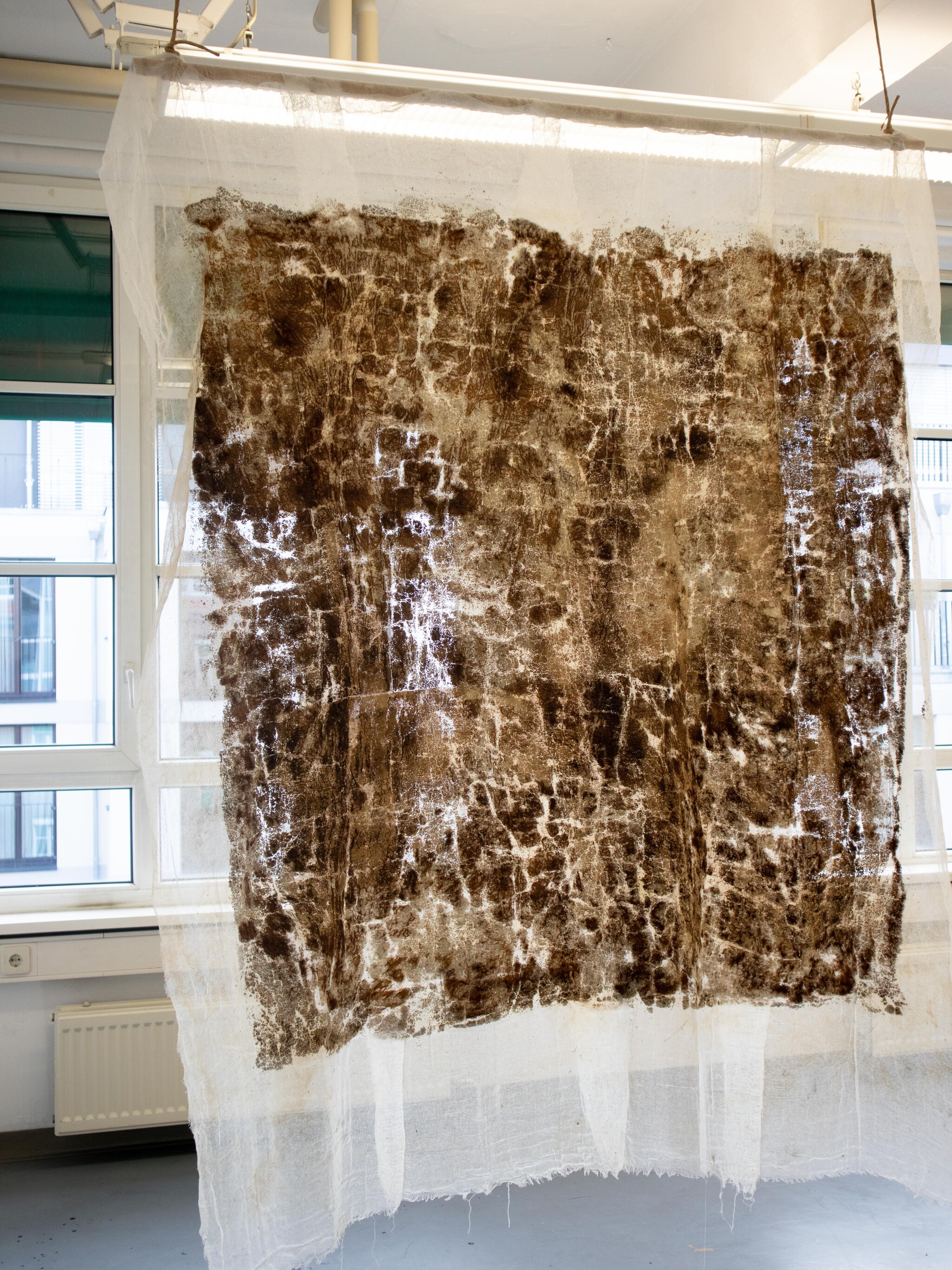
Sunlight Through Type O Green is a new iteration of an earlier installation. Once-living plant matter embedded in the textile has since decayed, dried, and flattened, leaving behind a preserved root structure—an organic artifact that has become its own painting. The work evokes themes of hauntology, ecological memory, deep time, death and material decay.
Alle Rechte vorbehalten Patricia Black
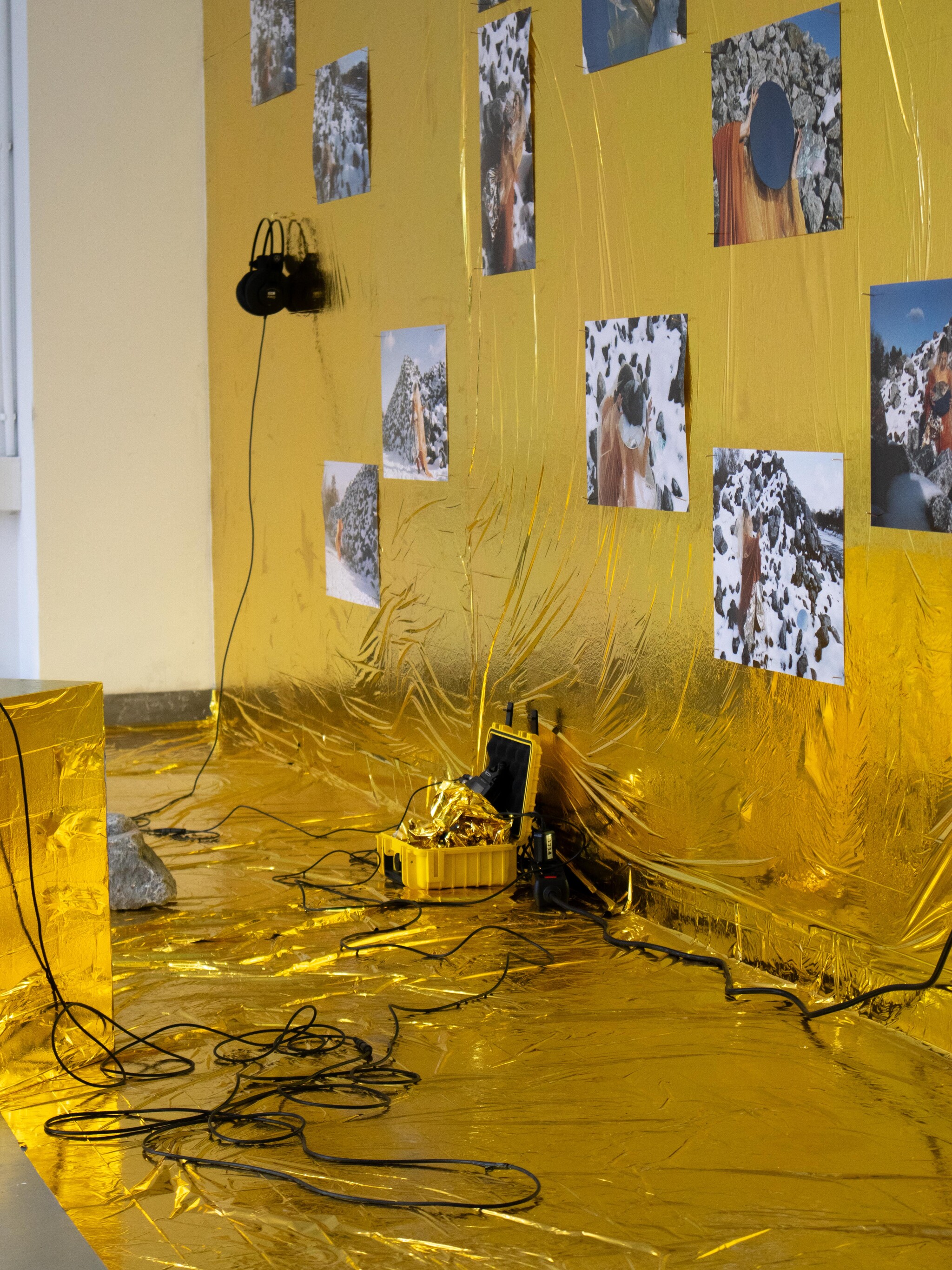
Everything is Inside weaves together a photo-performance and a sound piece, creating a speculative dialogue between visual and audio storytelling. Inspired by Oswald de Andrade’s Manifesto Antropofágico (Cannibal Manifesto) of the 1920s—a radical text advocating cultural cannibalism as a means of decolonization—the work reimagines existence through fragmentation, transformation, and rebirth.
At its core, the installation follows a metamorphic being—sometimes a mythic bird sustained by rocks, other times a woman sculpted from stone, or a consuming fire that reshapes reality. This entity embodies resilience, confronting destruction through dance, beauty, and joy, even amidst ruin. The sound piece, a prose poem, juxtaposes existential musings with mundane vignettes, while the photo-performance freezes moments of bodily and environmental transmutation. Together, they question permanence and impermanence, echoing the manifesto’s call to “devour” oppressive structures and forge new meanings from the fragments.
Everything is Inside invites viewers to witness a cycle of disintegration and renewal—where the body, like history, is both site and medium of transformation.
Alle Rechte vorbehalten Patricia Black
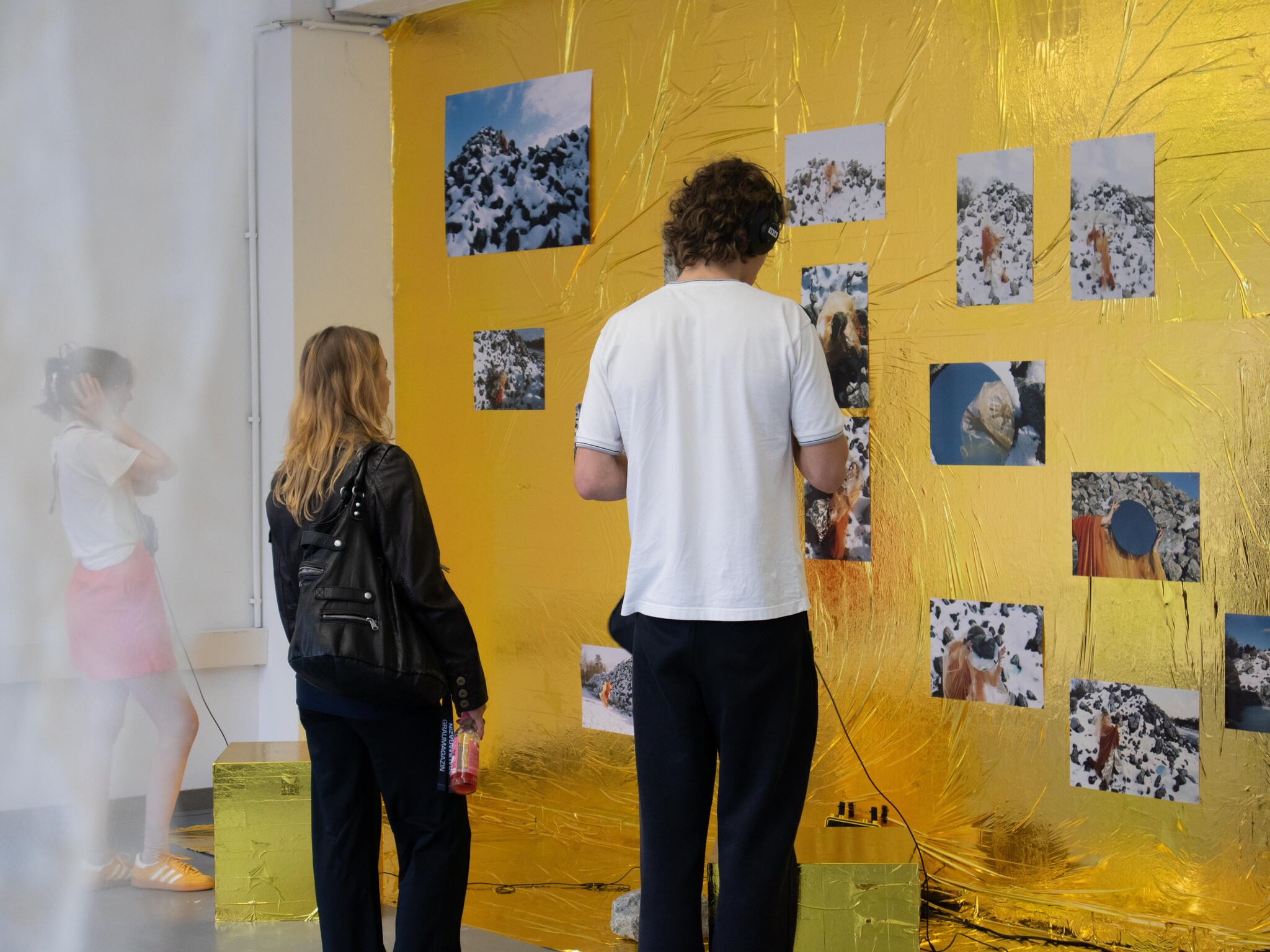
Everything is Inside weaves together a photo-performance and a sound piece, creating a speculative dialogue between visual and audio storytelling. Inspired by Oswald de Andrade’s Manifesto Antropofágico (Cannibal Manifesto) of the 1920s—a radical text advocating cultural cannibalism as a means of decolonization—the work reimagines existence through fragmentation, transformation, and rebirth.
At its core, the installation follows a metamorphic being—sometimes a mythic bird sustained by rocks, other times a woman sculpted from stone, or a consuming fire that reshapes reality. This entity embodies resilience, confronting destruction through dance, beauty, and joy, even amidst ruin. The sound piece, a prose poem, juxtaposes existential musings with mundane vignettes, while the photo-performance freezes moments of bodily and environmental transmutation. Together, they question permanence and impermanence, echoing the manifesto’s call to “devour” oppressive structures and forge new meanings from the fragments.
Everything is Inside invites viewers to witness a cycle of disintegration and renewal—where the body, like history, is both site and medium of transformation.
Alle Rechte vorbehalten Patricia Black
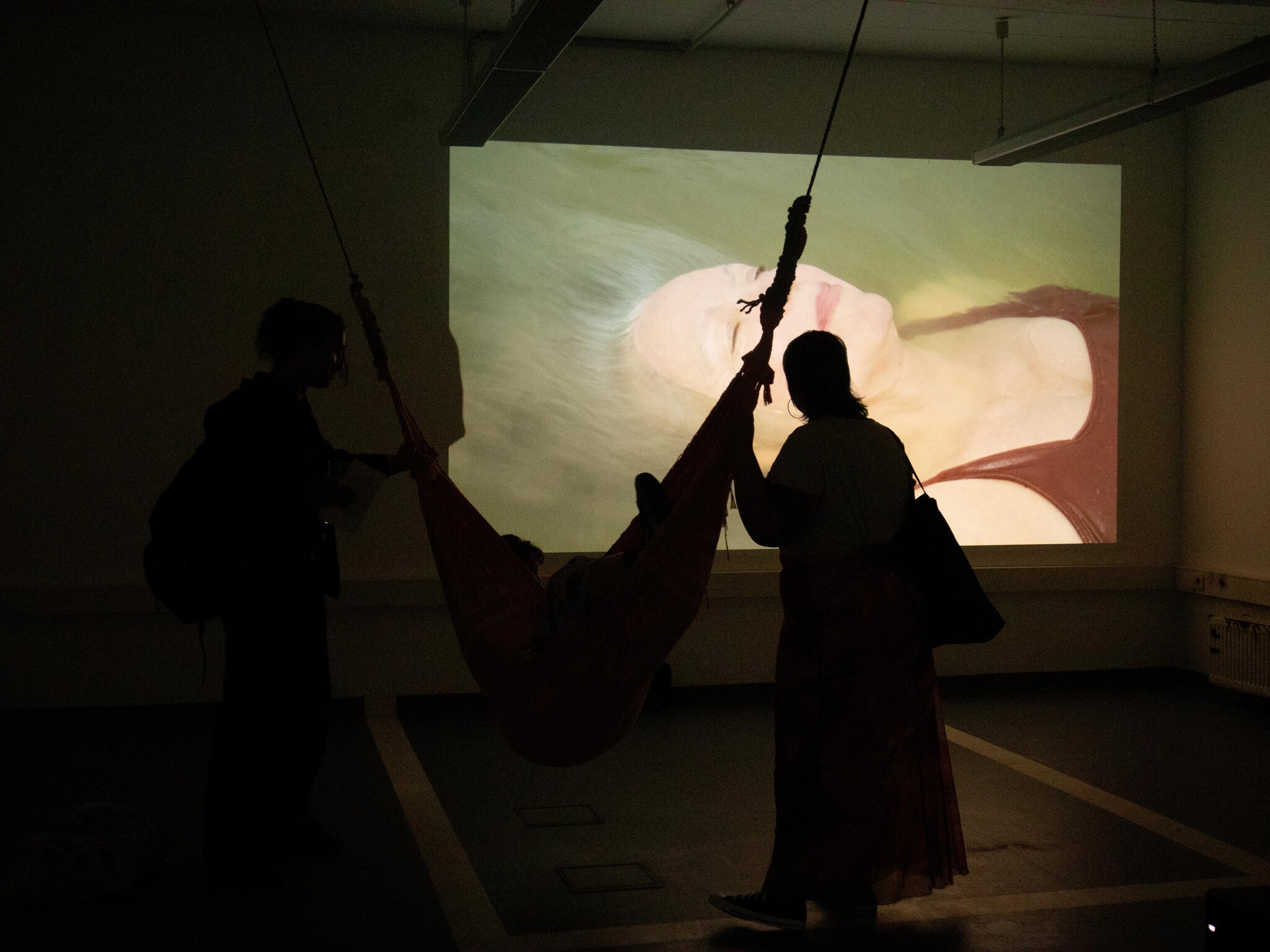
Thirty years after a sound expedition in the middle of the rainforest, Brazilian singer Tetê Espíndola is brought back to the Amazon by a reenacted space created by her own filmmaker daughter. The installation departs from the 1990 Macauã Expedition — a musical and ecological journey into the Acre region, where singer Tetê and a team of researchers explored the interplay between bird vocalizations and the human voice.
The pieces are exercises or rehearsal propositions to revisit that territory, reactivating its sonic ghosts within a contemporary ecology, attuning, imagining and collectively reperforming what that jungle could be. As her daughter, film director Patricia Black leans into the tender acoustics and personal mythologies of a maternal forest, where the absence of image invites a fiction to drift through kinship dreams.
Tetê Espíndola is a Brazilian singer, composer, and instrumentalist known for her distinctive vocal technique and experimentation with nature-inspired sound. Her practice is a continuous journey of exploration and recreation of Brazil’s ecological universe. Rehearsal for Open Sky and Closed Jungle is a larger unfolding dialogue between two generations, two points in History and a shared sonic territory separated by more than three decades.
#1 – Chapter II and IV
Tetê Espíndola floats down the Paraguay River in Corumbá (Brazil), reading aloud from Songs of the Open Sky and the Closed Jungle by Marta Catunda — an ecological educator and fellow participant in the 1990 Macauã Expedition. Written in the aftermath of that journey, the book weaves early Brazilian approaches to deep listening and land-based pedagogies from the Pantanal and Amazon, particularly through the musical seeds spread by birds.
#2 – Macauã Archive
This sound station offers access to some of the original DAT material recorded during the Macauã Expedition. Unreleased songs, boat conversations, field recordings and a historical vocal duet between Tetê and a Uirapuru-da-terra bird. A hammock — as commonly used during long river travellings — invites the listener to rest and surrender to the spectral crossing of Tetê's voice and the travelling soundscape.
Alle Rechte vorbehalten Patricia Black
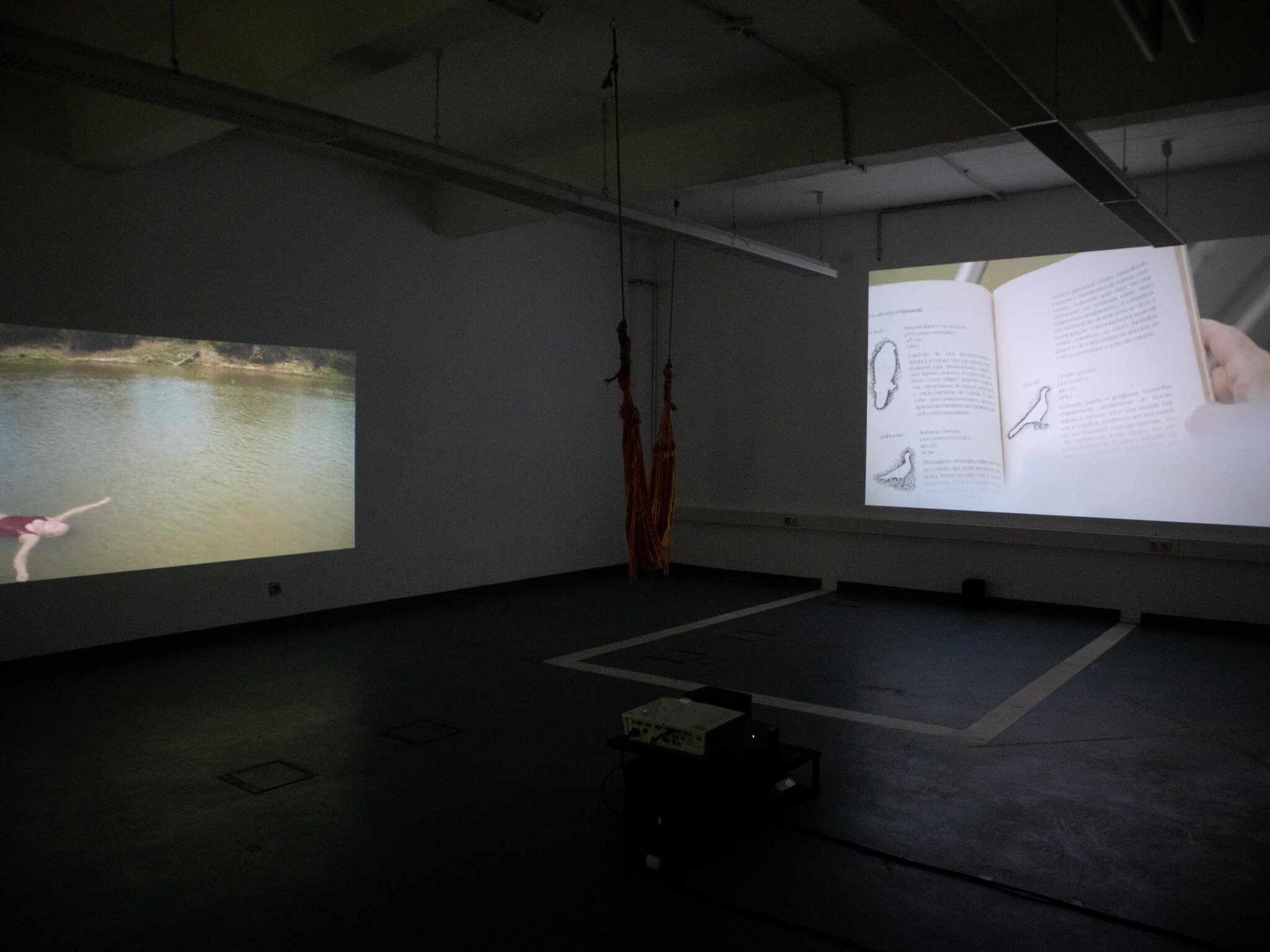
Thirty years after a sound expedition in the middle of the rainforest, Brazilian singer Tetê Espíndola is brought back to the Amazon by a reenacted space created by her own filmmaker daughter. The installation departs from the 1990 Macauã Expedition — a musical and ecological journey into the Acre region, where singer Tetê and a team of researchers explored the interplay between bird vocalizations and the human voice.
The pieces are exercises or rehearsal propositions to revisit that territory, reactivating its sonic ghosts within a contemporary ecology, attuning, imagining and collectively reperforming what that jungle could be. As her daughter, film director Patricia Black leans into the tender acoustics and personal mythologies of a maternal forest, where the absence of image invites a fiction to drift through kinship dreams.
Tetê Espíndola is a Brazilian singer, composer, and instrumentalist known for her distinctive vocal technique and experimentation with nature-inspired sound. Her practice is a continuous journey of exploration and recreation of Brazil’s ecological universe. Rehearsal for Open Sky and Closed Jungle is a larger unfolding dialogue between two generations, two points in History and a shared sonic territory separated by more than three decades.
#1 – Chapter II and IV
Tetê Espíndola floats down the Paraguay River in Corumbá (Brazil), reading aloud from Songs of the Open Sky and the Closed Jungle by Marta Catunda — an ecological educator and fellow participant in the 1990 Macauã Expedition. Written in the aftermath of that journey, the book weaves early Brazilian approaches to deep listening and land-based pedagogies from the Pantanal and Amazon, particularly through the musical seeds spread by birds.
#2 – Macauã Archive
This sound station offers access to some of the original DAT material recorded during the Macauã Expedition. Unreleased songs, boat conversations, field recordings and a historical vocal duet between Tetê and a Uirapuru-da-terra bird. A hammock — as commonly used during long river travellings — invites the listener to rest and surrender to the spectral crossing of Tetê's voice and the travelling soundscape.
Alle Rechte vorbehalten Patricia Black
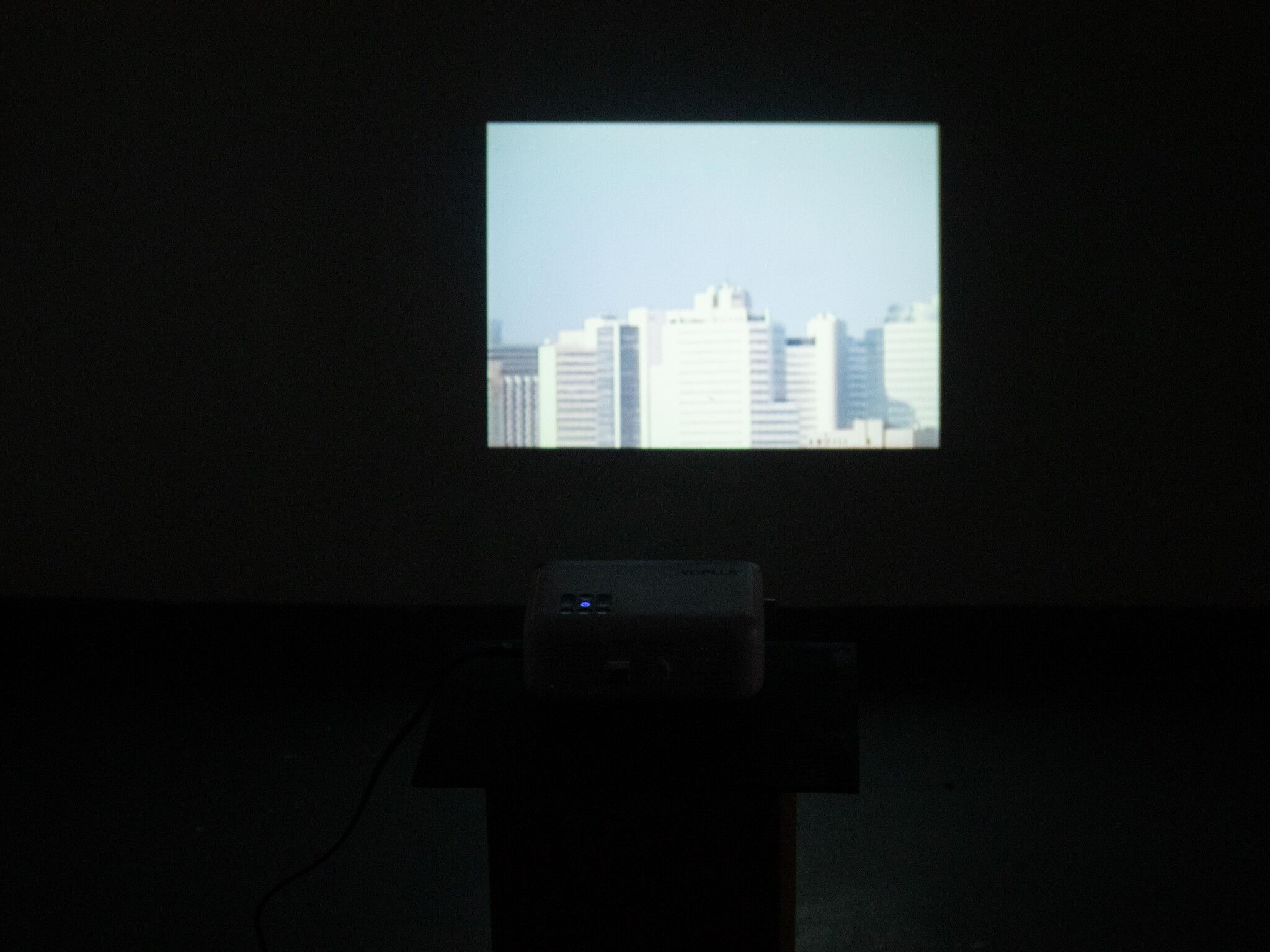
Compilation of bird footage filmed during wartime. Duration variable. Projected directly onto the wall.
A quiet study of movement, tension, and the instinct to flee.
Alle Rechte vorbehalten Patricia Black
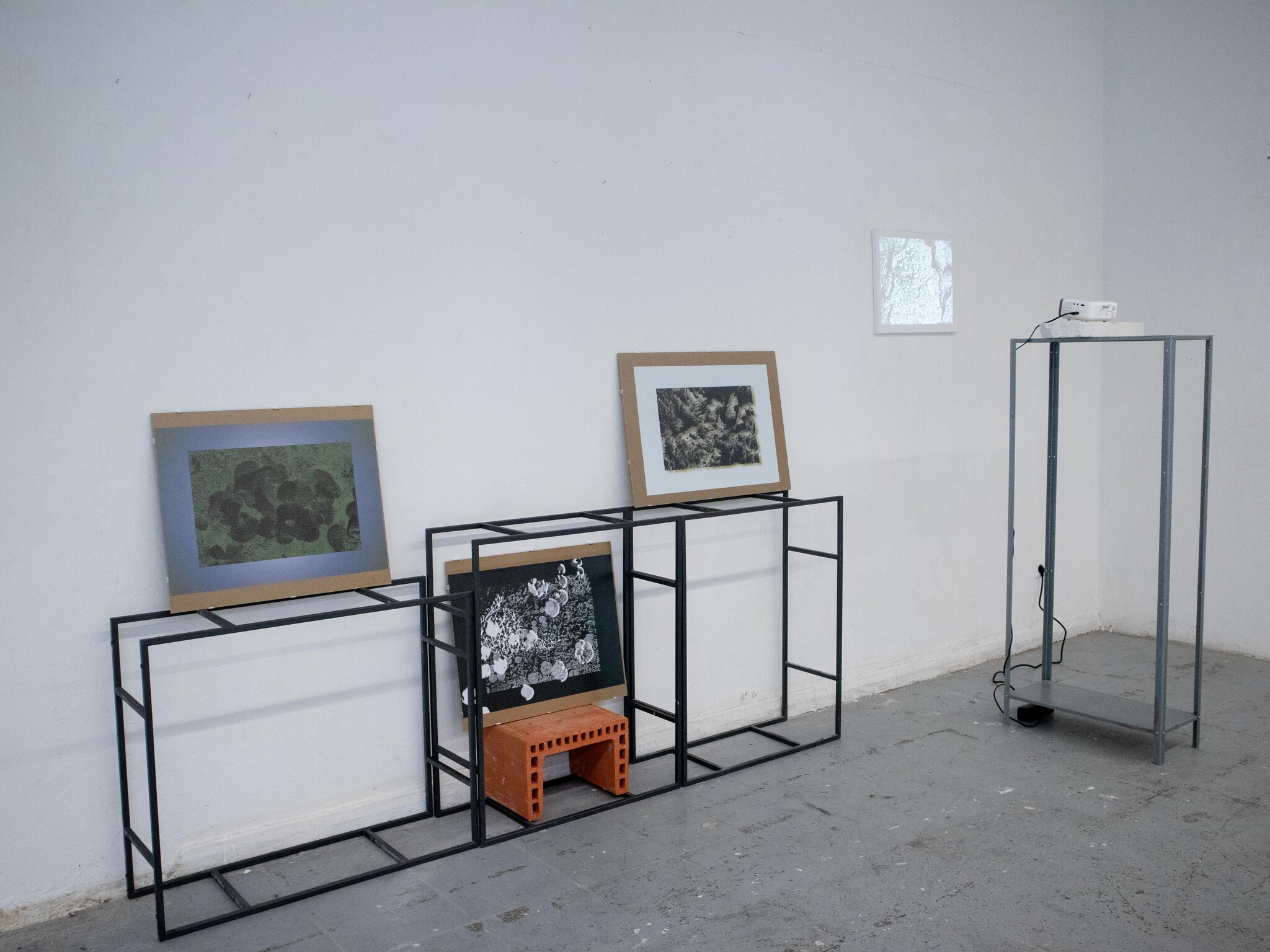
Single-channel projection on screen (50 x 60 cm), 6’19”
A video piece on lichens, filmed at Floating University. An exploration of matter, surface, and slow time
Alle Rechte vorbehalten Patricia Black